¶ Introduction
In order to understand what a legal register is, one needs to distinguish between a legal register and a legal library, both commonly used and confused.
- A legal library is either an electronic or hard copy of different Acts and their Regulations that are populated to a designated website or to a hard copy library.
- A legal register is interpreted by industry in general as a legal library that is broken down into specific legal requirements set on a specific client for a specific area(s) or a company as a whole. It is a general interpretation of the applicable law that states in layman’s terms what the client has to do to meet the specific requirement set in the specific section, subsection, paragraph and subparagraph. It is thus not only a copy of the relevant Act and Regulations but also an interpretation of the legal requirement set on the client in terms of that Act & Regulations. This is then applied to all legislation that is relevant to the client in terms of Occupational Health & Safety, Environmental and Quality Legislation.
Self-assessment is a valuable tool to help identify internal control deficiencies. This tool will assist in departmental management, as well as audit preparation. The self-assessment consists of a series of “yes” or “no” questions. “Yes” indicates adequate controls in an area, while “no” indicates control deficiencies..
These details include:
- Starting with a legal register that includes a list of Legal obligations.
- Allowing users to do a high level risk assessment if these obligations are not complied with.
- Creating a Questionnaire based on question and asnwer types.
- Distributing these Questionnaires to users.
The owner of Immovable Property is the person in whose name the property is registered in terms of the Deeds Registries Act. A Title Deed is the owner of immovable property's documentary proof of ownership. Each privately owned property has its own separate Title Deed, which is an important document containing all the details pertaining to a specific piece of land.
These details are:
- The names of the existing owner as well as the previous owner.
- A full description of the property, including its measured size.
- The purchase price of the property paid by the existing owner.
- All conditions restricting the use or the sale of the property.
All limited real rights registered in respect of the property and what their nature is - These details not only restrict an owner, but they also affect the value of the property. In certain instances, they protect the owner where, for example, you may not build over a certain building line on your property's boundary wall, so as to create space between neighbors. Another example is that the property in front of yours may not block your ocean view with buildings higher than 2 storys.
The owner of immovable property will normally have the Title Deed of his property in his possession, usually in the form of a Deed of Transfer, if the property is fully paid for. However, the Deed of Transfer may be in the possession of the bank, which holds a Mortgage Bond over the property.
What are The Deeds Office and The Deeds Registry?
A Deeds Office holds a Deeds Registry, containing filed Title Deeds of all the properties in its particular jurisdiction. All the Deeds Registries are linked to a computer network. Your estate agent can, via a computer-linked facility from his office, examine any Title Deed in the country's combined Deeds Registry.
Trademarks rights must be maintained through actual lawful use of the trademark. These rights will cease if a mark is not actively used for a period of time, normally 5 years in most jurisdictions. In the case of a trademark registration, failure to actively use the mark in the lawful course of trade, or to enforce the registration in the event of infringement, may also expose the registration itself to become liable for an application for the removal from the register after a certain period of time on the grounds of "non-use".
It is not necessary for a trademark owner to take enforcement action against all infringement if it can be shown that the owner perceived the infringement to be minor and inconsequential. This is designed to prevent owners from continually being tied up in litigation for fear of cancellation. An owner can at any time commence action for infringement against a third party as long as it had not previously notified the third party of its discontent following third party use and then failed to take action within a reasonable period of time (called acquiescence). The owner can always reserve the right to take legal action until a court decides that the third party had gained notoriety which the owner 'must' have been aware of. It will be for the third party to prove their use of the mark is substantial as it is the onus of a company using a mark to check they are not infringing previously registered rights. In the US, owing to the overwhelming number of unregistered rights, trademark applicants are advised to perform searches not just of the trademark register but of local business directories and relevant trade press. Specialized search companies perform such tasks prior to application.
All jurisdictions with a mature trademark registration system provide a mechanism for removal in the event of such non-use, which is usually a period of either three or five years.
¶ Navigation

¶ Specific setups
The following is required and will be covered in detail below:
- Legal category
- Right type
Take note and read ISO standards as 19600 (Now 37301).
ISO 19600 helps organizations to establish, develop, evaluate, and maintain a compliance management system. It brings together separate strands of compliance management and risk management, and its processes align very closely with ISO 31000, another risk management standard.
Many existing compliance standards focus on one specific regulatory requirement or topic area. ISO 19600 aims to unify these so that organizations can work within a single framework rather than several different ones focusing on different standards. Unlike PS 980, ISO does not mandate any specific auditing requirements. ISO 19600 is "based on the principles of good governance, proportionality, transparency and sustainability".
Laws/Acts and their sections are referenced.
Users can keep track of any specific laws and pertinent clauses. These in return could be referenced in the Policies. (See “Area of compliance” header)
¶ Step 1: Setup Legal category
Go to: GRC > Governance > Setup for governance > Legal category
- On the Action pane, click on the New button
- Enter a unique Legal category ID
- Enter a brief Description for the legal category

¶ Step 2: Legislation
Acts/laws with their sections are updated and maintained on the Legislation form.
Go to: GRC > Governance > Legal > Legislation
- In the Action pane, click on the New button
- Expand the General Fast tab
- In the Act field, enter the unique name for the Compliance act
- In the Number field, enter the Compliance act number
- Enter the Year
- Enter a brief Description of the act
- Select the relevant Status of the Compliance act from the dropdown list
- Select the Date that the act was introduced
- Select the Date on which the act was reviewed
- Enter the name of the Governing body
- Indicate whether a Copyright exists on the act
- Enter the Scope and purpose of the legislation in the note box provided
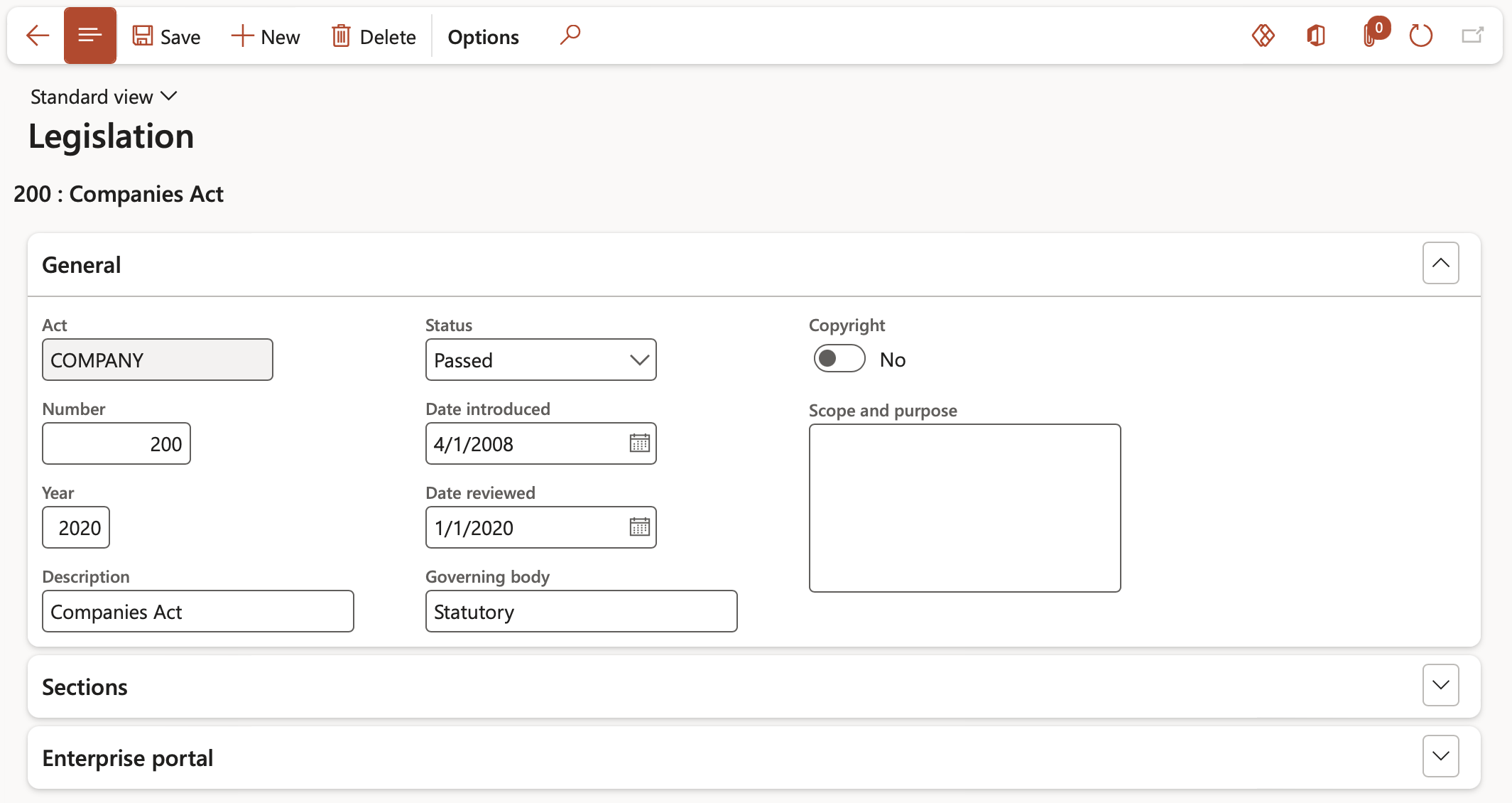
- Expand the Sections Fast tab
- Click on the Add button
- Enter a Section number
- Enter the Section name
- Select the date on which the section of the act was last updated
- Select the external system where the section was updated from:
- LexisNexis
- Sabinet
- Other
- Enter a Description of the section in the note box provided

- Expand the Enterprise portal Fast tab
- Click on the Add button
- Select the relevant Purpose from the dropdown list
- Enter the relevant Internet address
- Click Save
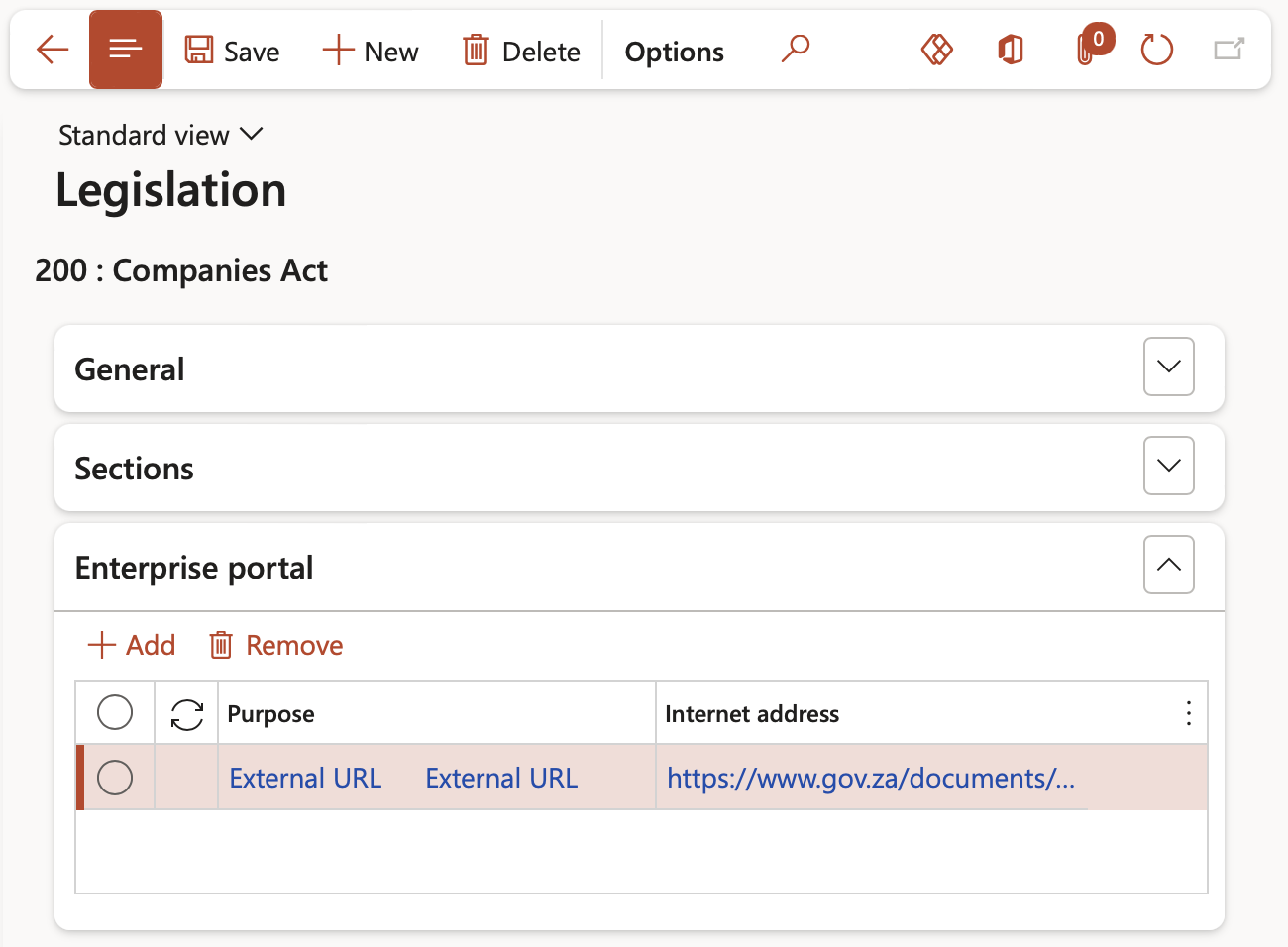
¶ Step 3: Right type
Go to: GRC > Governance > Setup for governance > Right type
- On the Action pane, click on the New button
- Enter a unique Right type ID
- Enter a brief Description for the right type
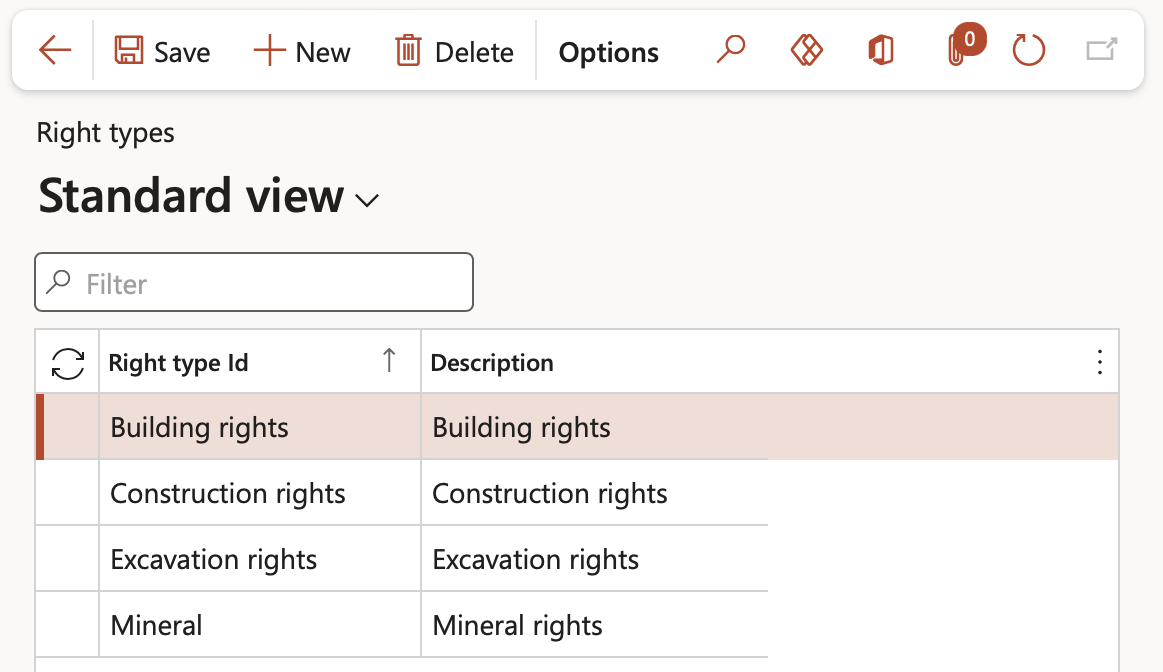
¶ Step 4: Process and activity
Go to: HSE > Setup > Process and activity
- On the Action pane, click on the New button
- Under the General Fast tab, enter a unique Process ID
- Enter a brief Description
- Expand the Activities Fast tab
- In the Button strip, click on the Add button
- Enter the SOP#
- Enter the Activity ID
- Enter a brief Description for the activity
- Enter a additional Notes in the box provided
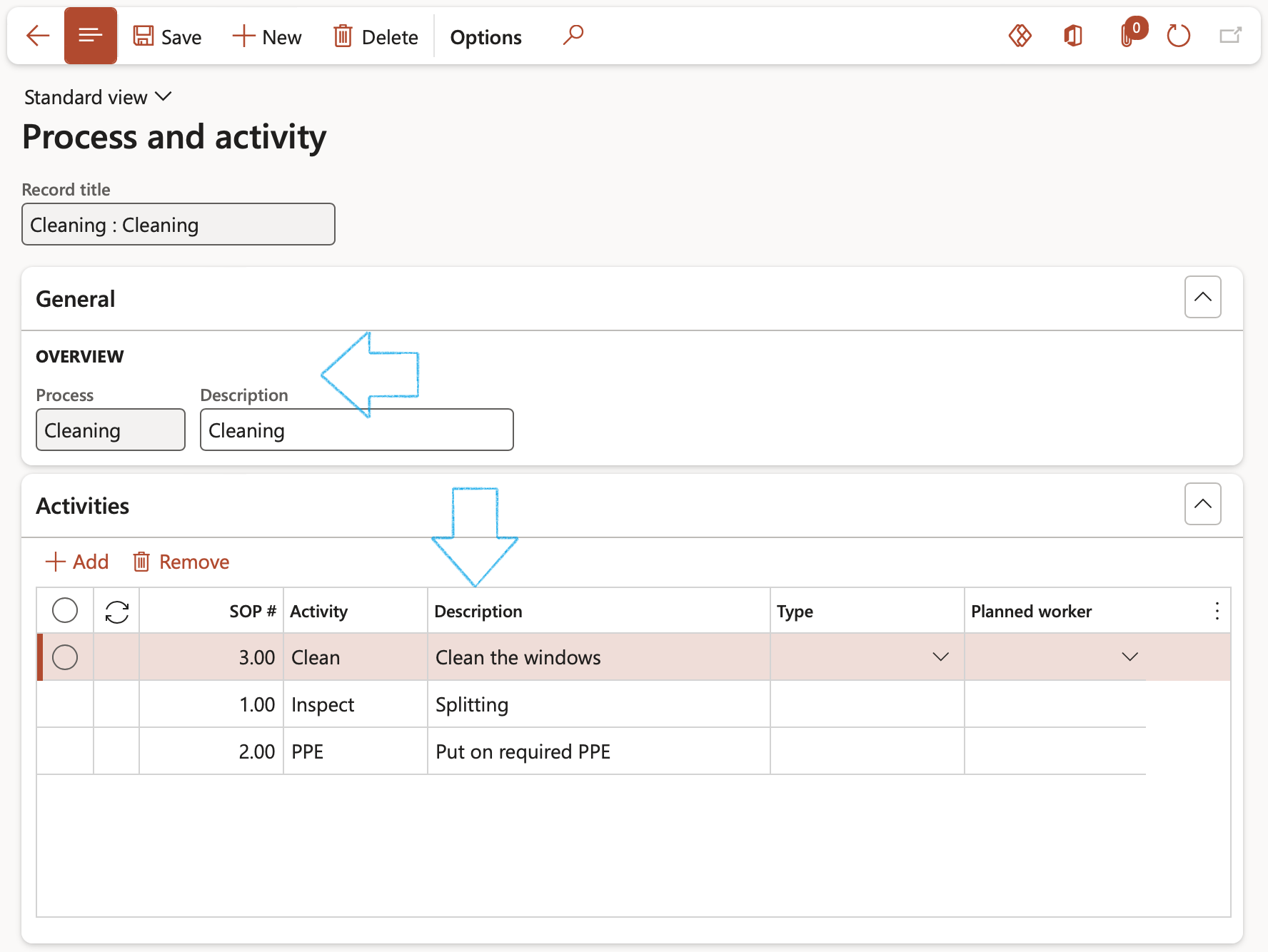
¶ Step 5: Questionnaires
A questionnaire is a set of questions that is used to collect information for various purposes. A questionnaire may be used to test the professional skills of employees, test course participants at the end of a course, survey employee and customer satisfaction, or evaluate employee job performance. Inside Dynamics GRC 365 it is also used in the context of legal entities and compliance (audit) self-assessments.
Users can use Microsoft Dynamics GRC 365 to design, distribute, and complete questionnaires, and then analyze the results. The design phase includes four groups of tasks that users must complete in the following order:
- Set up prerequisites, as required.
- Set up answer groups and answers, if applicable.
- Set up questions and their association with the answer groups.
- Set up the questionnaire itself, and attach questions to it.
The four main components are summarised below, using a workplace health assessment as an example:
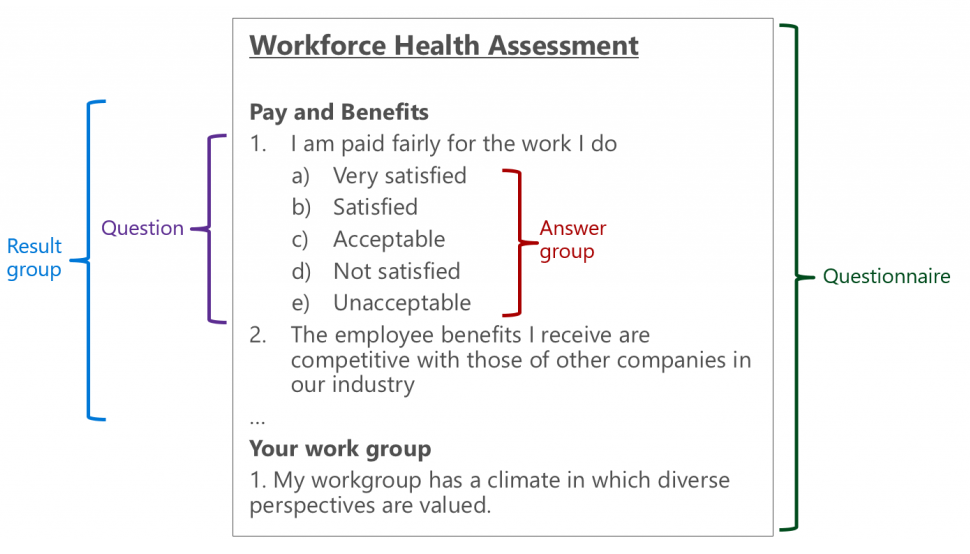
¶ Step 5.1: Question types
Question types are required and must be assigned when you create a question. Use Question types to categorize questions for reporting.
Questions types also make it easier to find questions, because you can use types as filters on the Questions page.
Go to: GRC > Compliance > Setup for compliance > Question types
- In the Action pane, click on the New button
- Enter the question Type and a Description
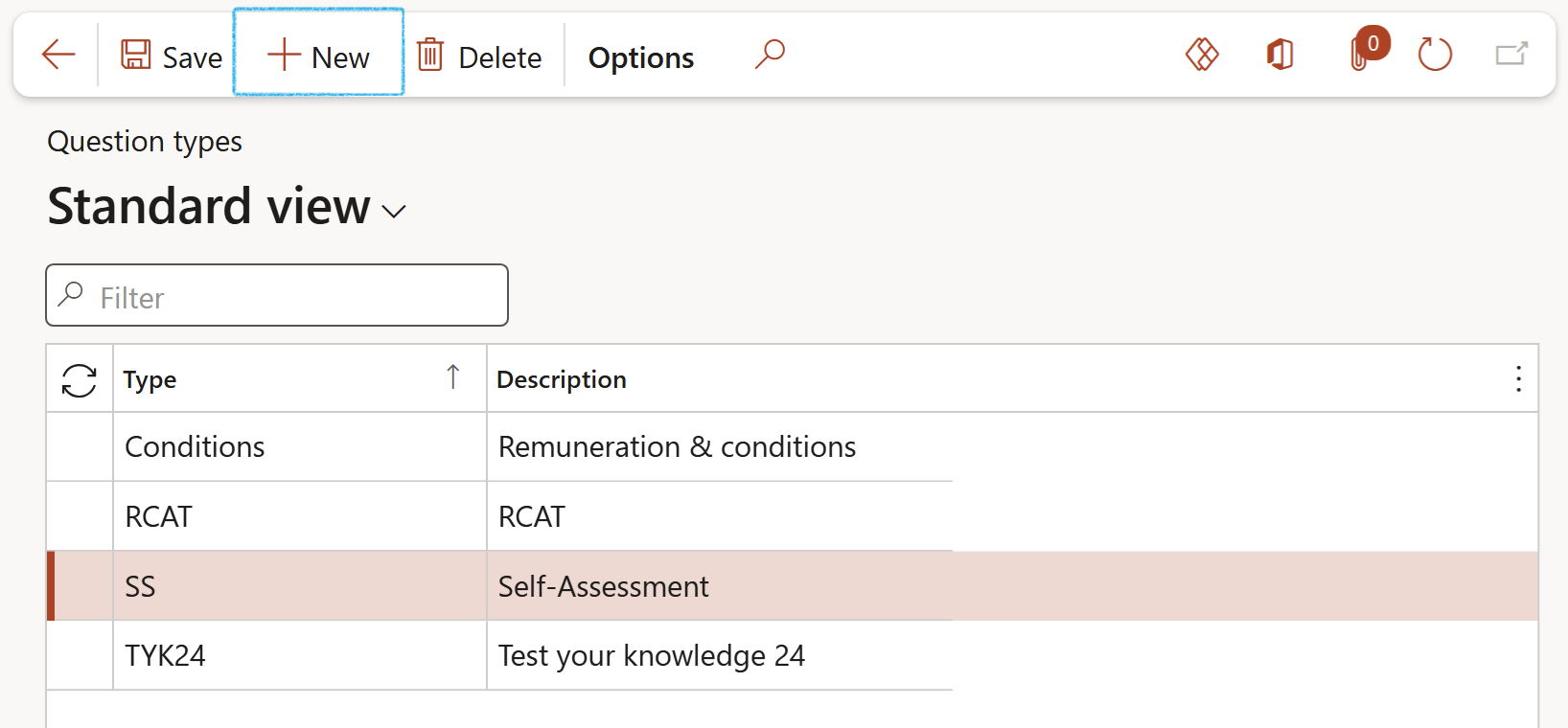
¶ Step 5.2: Questionnaire type
To begin creating our questionnaire in Dynamics GRC 365, we also need to create a Questionnaire type. This allows users to group or categorize questionnaires.
Go to: GRC > Compliance > Setup for compliance > Questionnaire types
- In the Action pane, click on the New button
- Enter the Type of questionnaire and a Description
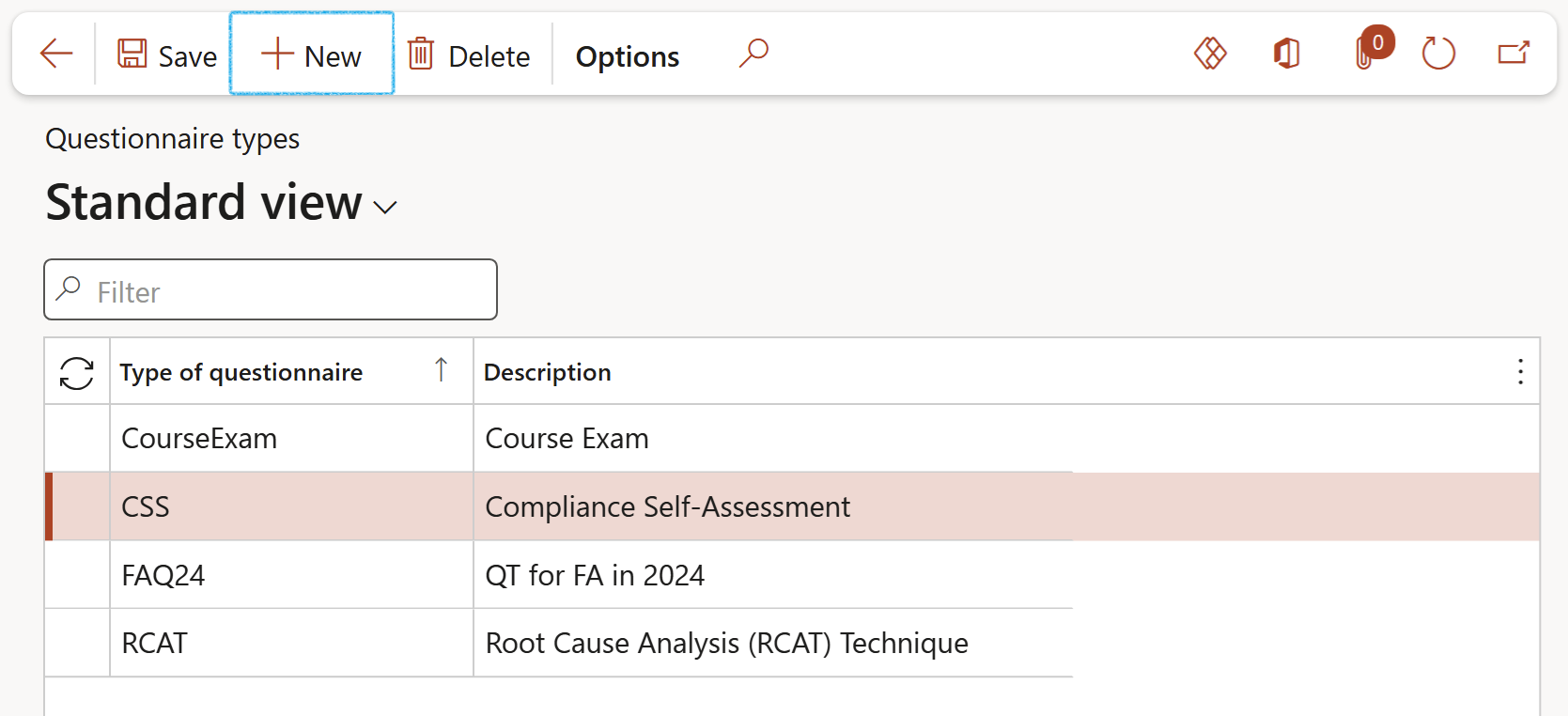
¶ Step 5.3: Questionnaire user groups
Questionnaire user groups are needed to distribute the questionnaires that were created so that they are available to the person or group of people who need complete them.
Go to: GRC > Compliance > Setup for compliance > Questionnaire user groups
- In the Action pane, click on the New button
- Enter the name of the Group and a Description
- To add Members to the user group, select the relevant group and click on the Members button in the Action pane

- On the Questionnaire group members form, in the Action pane, click on the New button
- Select the relevant Person from the dropdown list

If this user group is selected in creating a questionnaire later in the process, these members will receive and be responsible for completing the questionnaire
¶ Step 5.4: GRC parameters
The Answer group and Input type for Compliance self-assessment questionnaires have to be specified on the GRC parameters.
Go to: GRC > Setup > Governance, Risk and Compliance parameters
- Open the Compliance and audit tab
- Expand the Self-assessment Fast tab
- Select the relevant Answer group from the dropdown list
- Select the relevant Input type from the dropdown list

¶ Step 6: Audit type
The audit type setup is used for the Compliance self-assessments
Go to: GRC > Compliance > Setup for compliance > Audit type
- On the Action pane, click on the New button
- Enter a name for the Audit type
- Enter a Description for the audit type
- Tick the box in the Self-assessment column
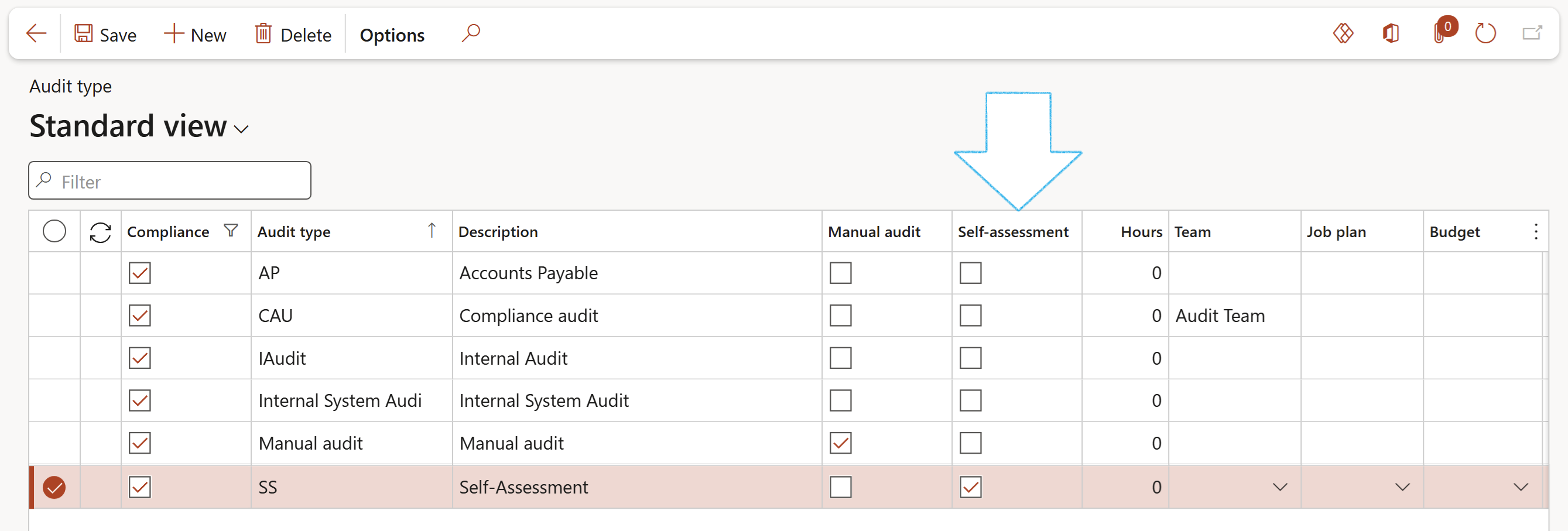
¶ Daily use
¶ Step 6: Legal register
This is the application of a legal act into the enterprise’s context.
Go to: GRC > Governance > Legal > Legal register
- On the Action pane, click on the New button
- Enter a Name for the Legal register
- In the Created by user field, select the relevant user from the dropdown list
- Select the Date on which the record was created
- In the Legislation field, select the relevant Compliance act from the dropdown list
- The Governing body field will automatically be populated with the relevant information according to the selection in the Legislation field
- The Legal register can be marked as Closed if it is no longer in use
- Expand the General Fast tab
- Enter a Description
- Enter a Version number
- Select the relevant values under the RISKS field group
- Select the relevant values under the OTHER field group
Once the Legal register has been saved, the Name field will only be editable for users in the Admin user group
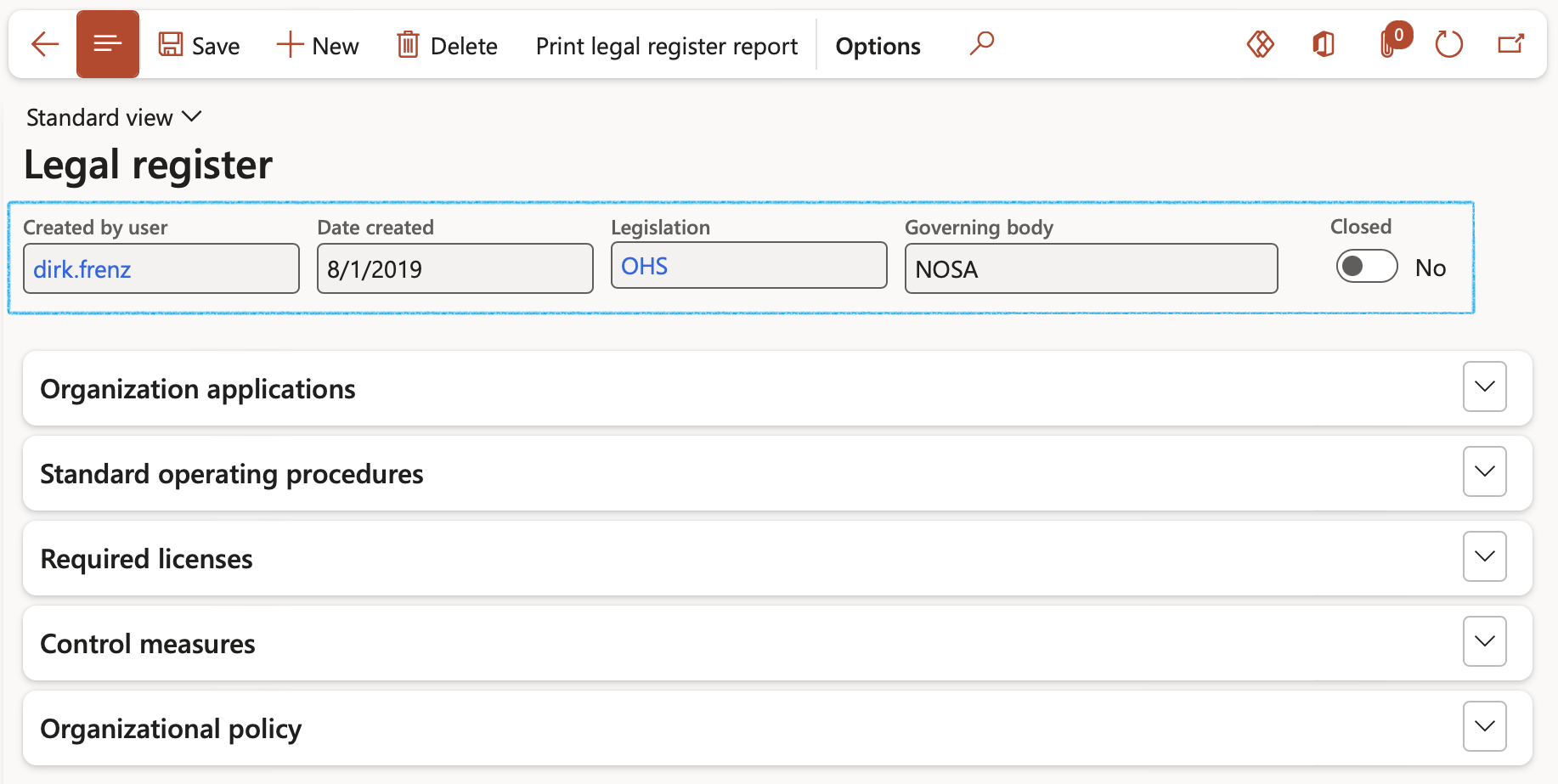
- Expand the Organization applications Fast tab
- Click on the Add button
- Select the relevant Site from the dropdown list
- Select the relevant Department from the dropdown list
- Select the relevant Project ID from the dropdown list (If applicable)
- Select the relevant Section name from the dropdown list
- In the Organization application field, enter details of how the legislation applies to the organisation/site
- Select the relevant SOP from the dropdown list
- Select the Responsible person from the dropdown list
- Enter the Application notes/comments in the note box provided
- In the Training requirements note box, enter the training that is required for the worker who is responsible for the legislation
- Enter the Compliance requirements in the note box provided
- Select the Due date for the activity
- In the Button strip, click on the Create activity button
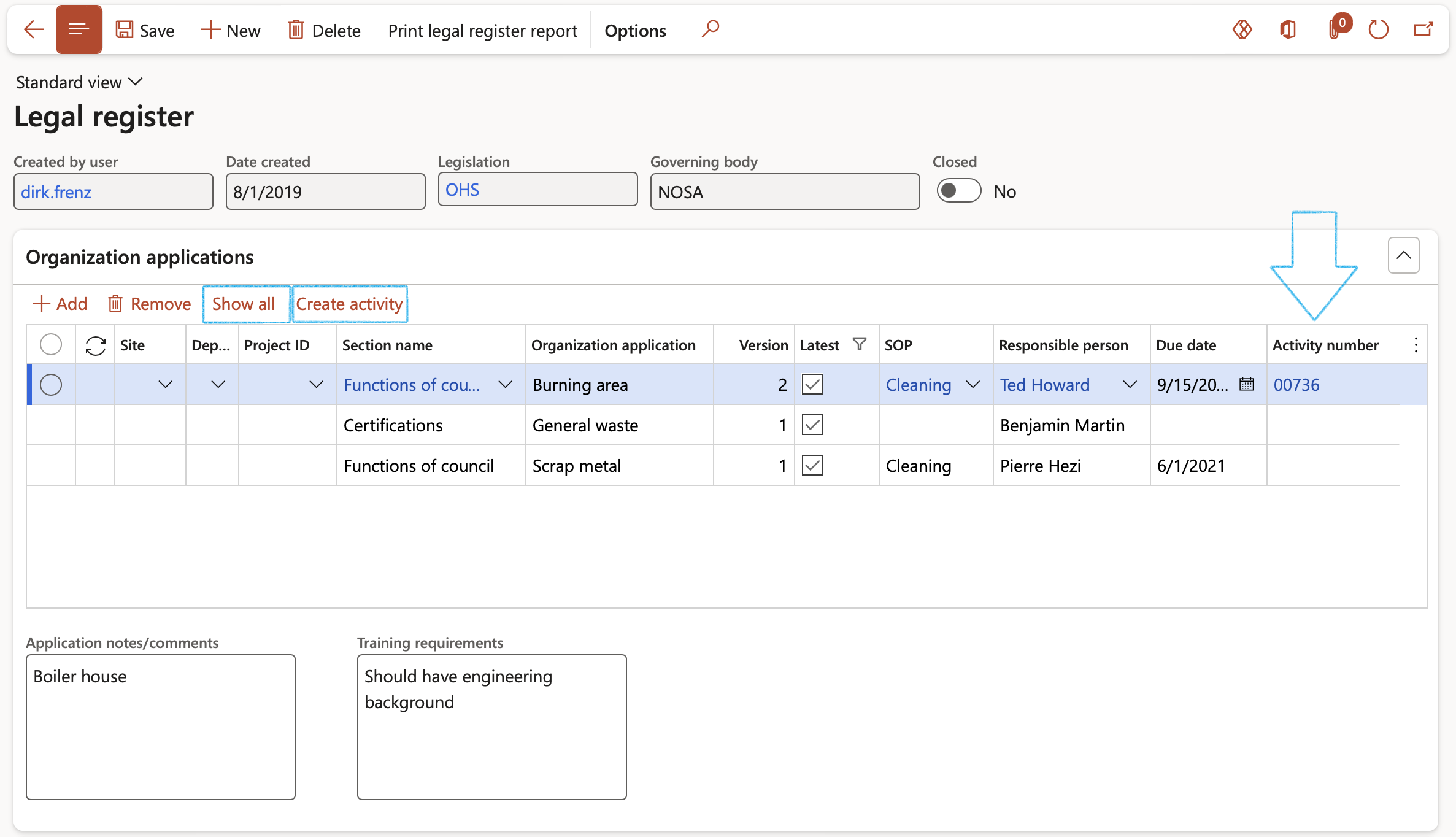
- When the user clicks on the Create activity button and creates an activity, the Activity number will be displayed
- The user can choose to see the all the records or only the latest records by clicking on the Show all button in the button strip
- Expand the Standard operating procedures Fast tab to view the SOP lines of the selected SOP above
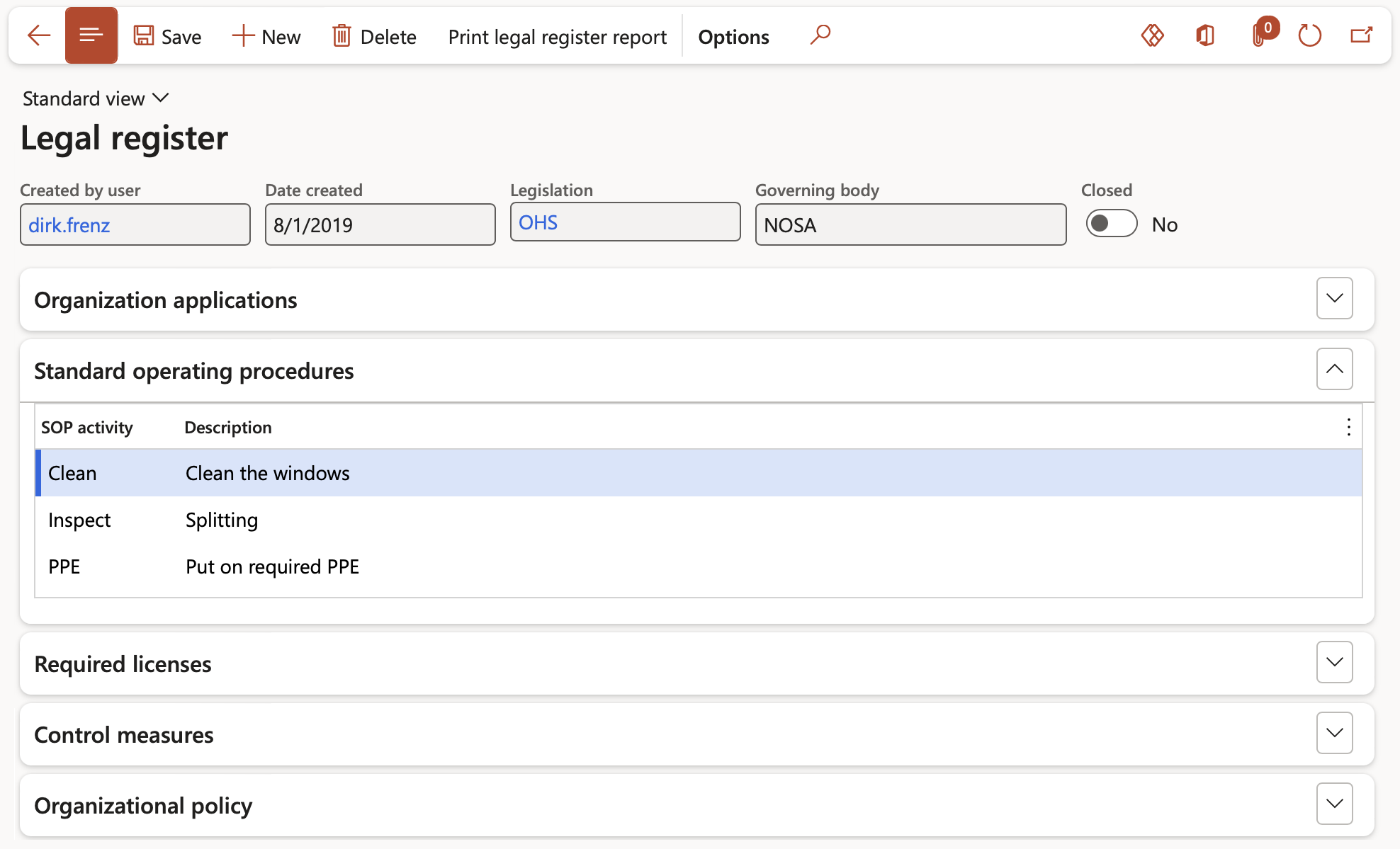
- Expand the Required licenses Fast tab
- Click on the Add button
- In the License field, select the relevant license from the dropdown list
- Enter a brief Description of the license
- The From date field will be populated according to the license selected
- The To date field will be populated according to the license selected
- Enter additional Notes/comments
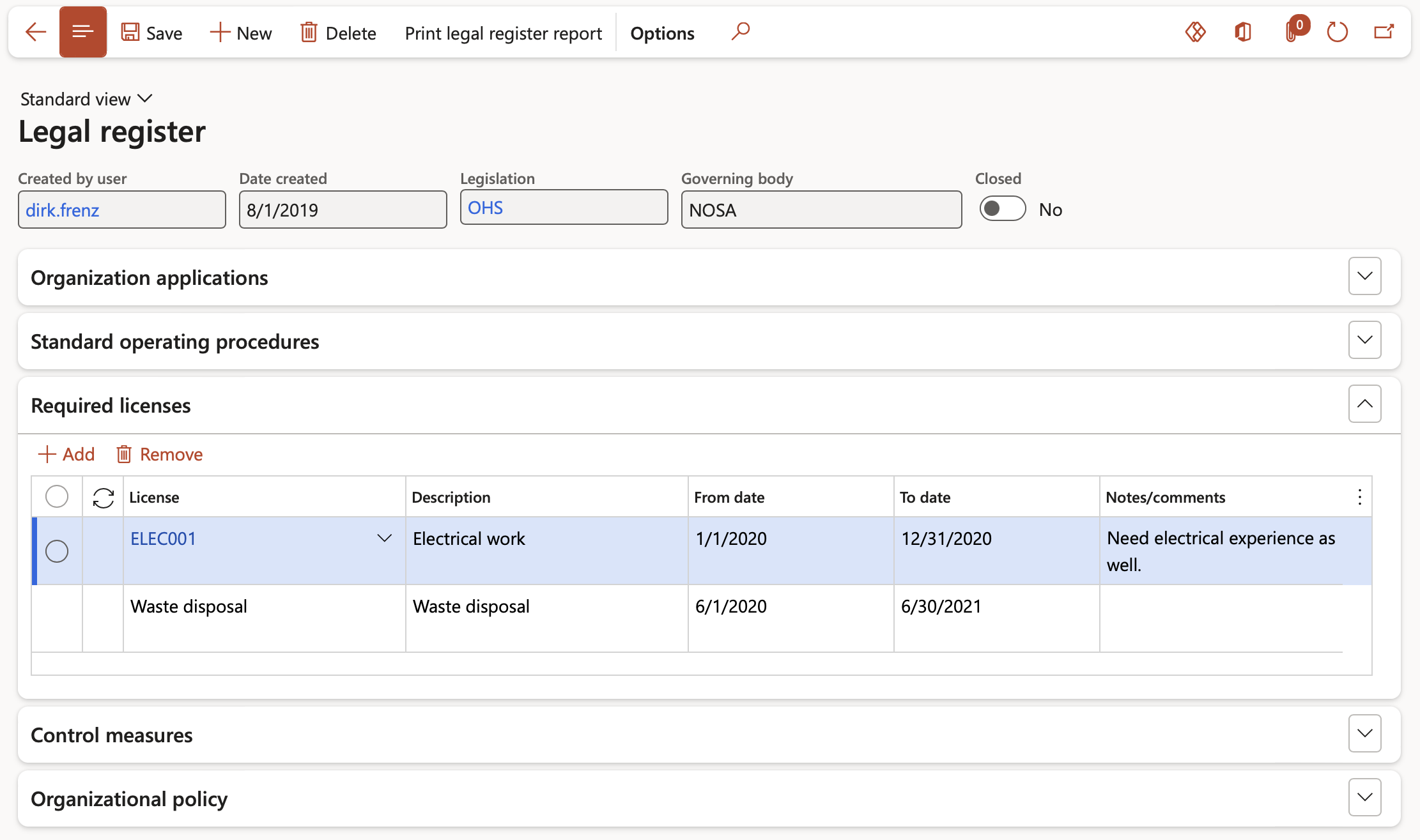
- Expand the Control measures Fast tab
- Click on the Add button
- In the Control measure field, select the required control measure from the dropdown list
- The Control type and Description fields will be populated with the relevant information according to the Control measure selected
- Enter additional Notes/comments
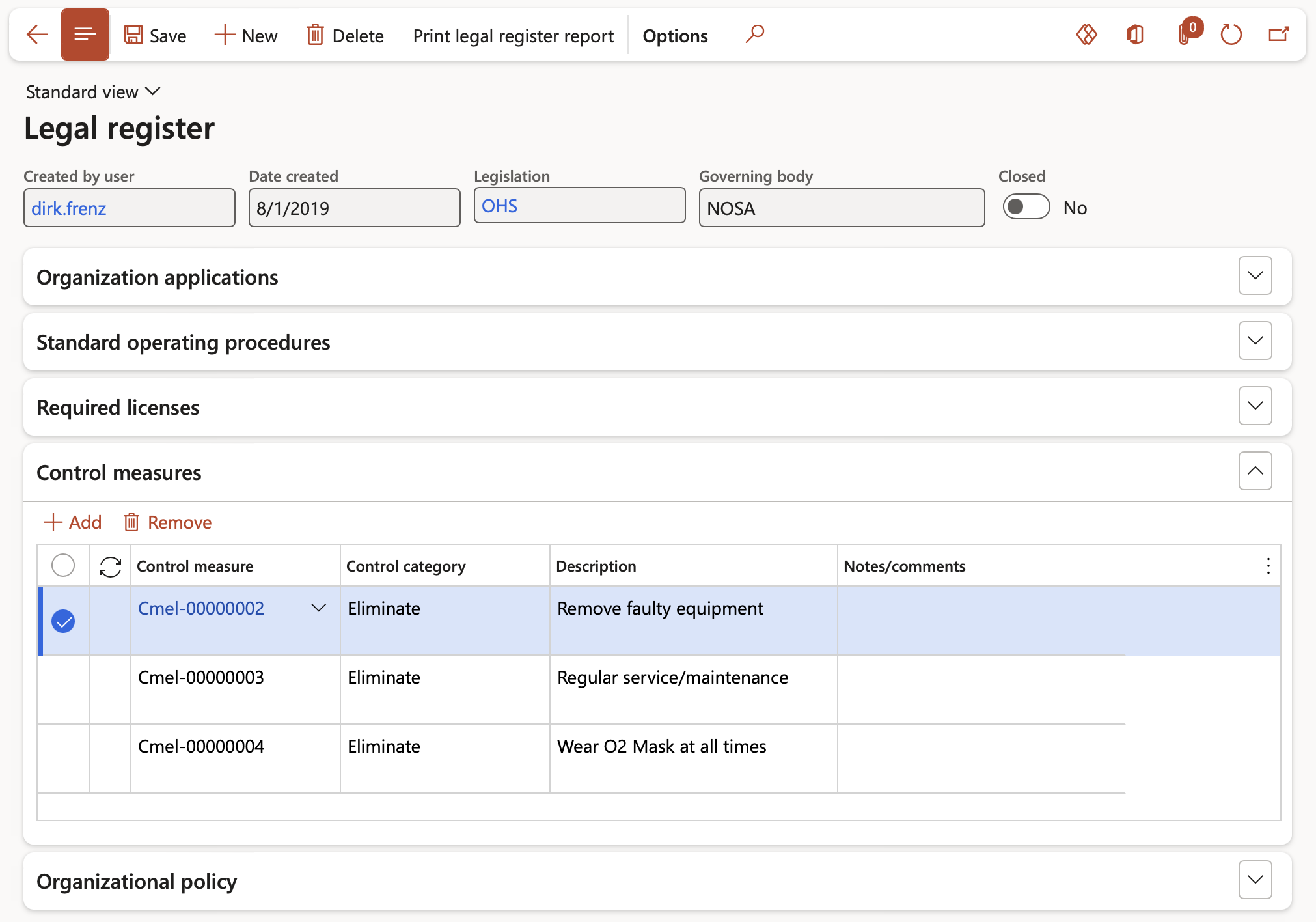
- Expand the Organizational policy Fast tab
- Select the relevant Clause from the dropdown list
- Click Save
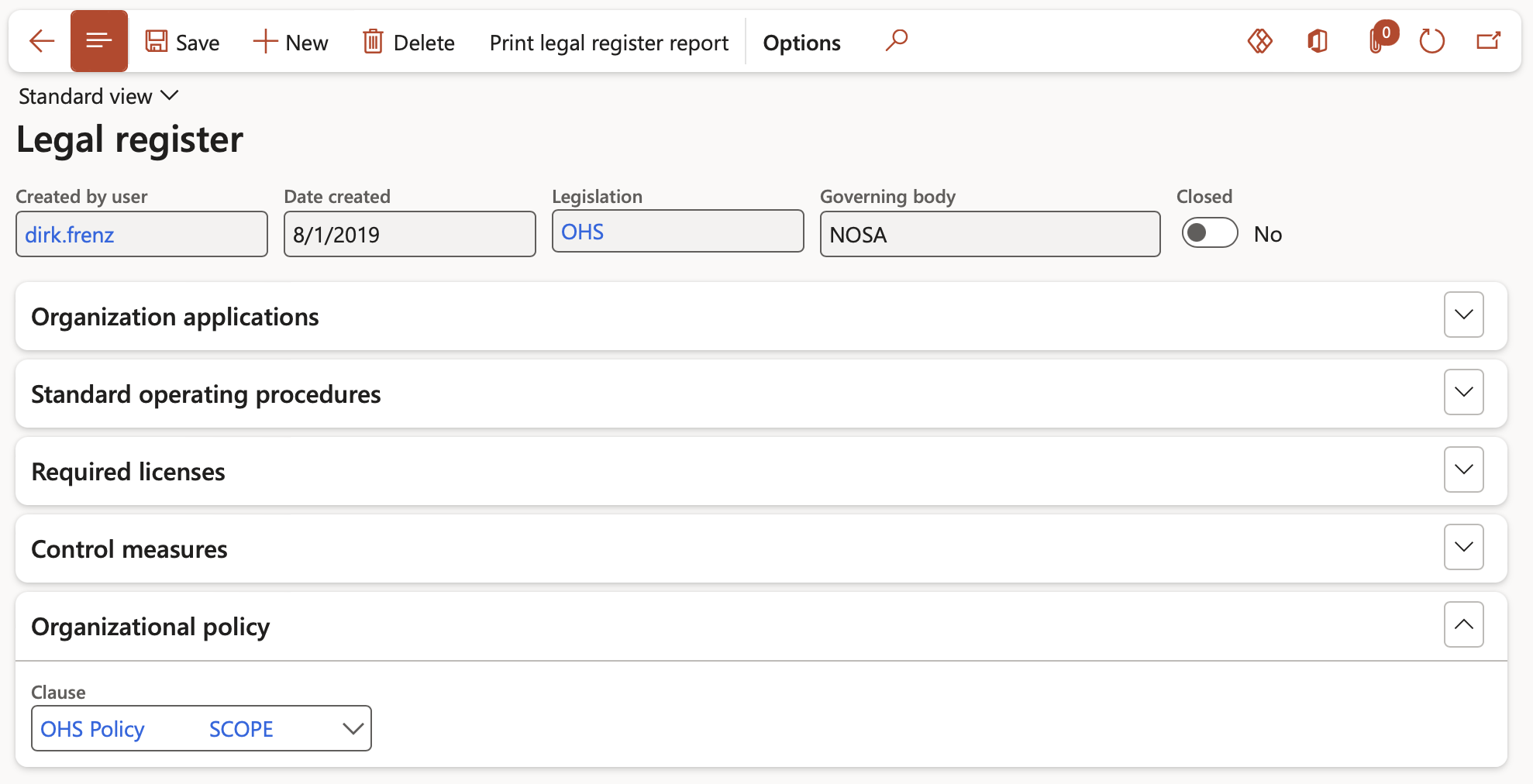
The Policy clauses that are selectable here, are set up under HSE > Incidents > Policies
¶ Step 7: Self-assessments
Compliance self-assessment is a process that helps organizations to manage their risks to achieve their business objectives. It involves a structured approach to documenting business objectives, risks, and controls, and having operational management and staff assess the adequacy of controls. A self-assessment is a great way to probe an organization's level of preparedness for an auditing process without the associated cost. Questionnaires provide a systematic framework for going through the self-assessment process.
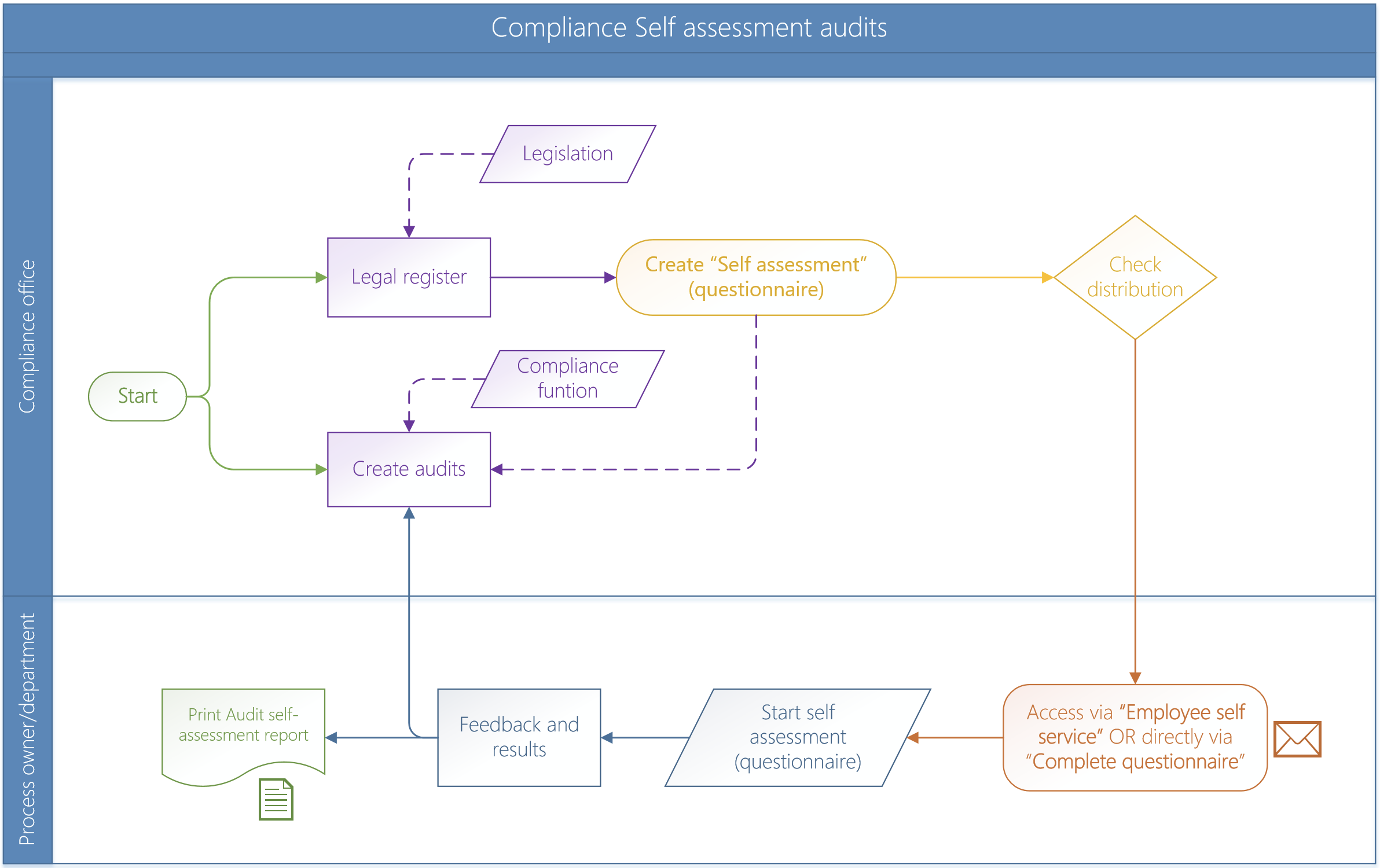
¶ Step 7.1: Legal register
Go to: GRC > Governance > Legal > Legal register
- Select the relevant Legal register, or create a new Legal register as descibed above
Please note that the text entered in the Compliance requirements note box under the Organisation applications Fast tab, will be the question text on the questionnaire
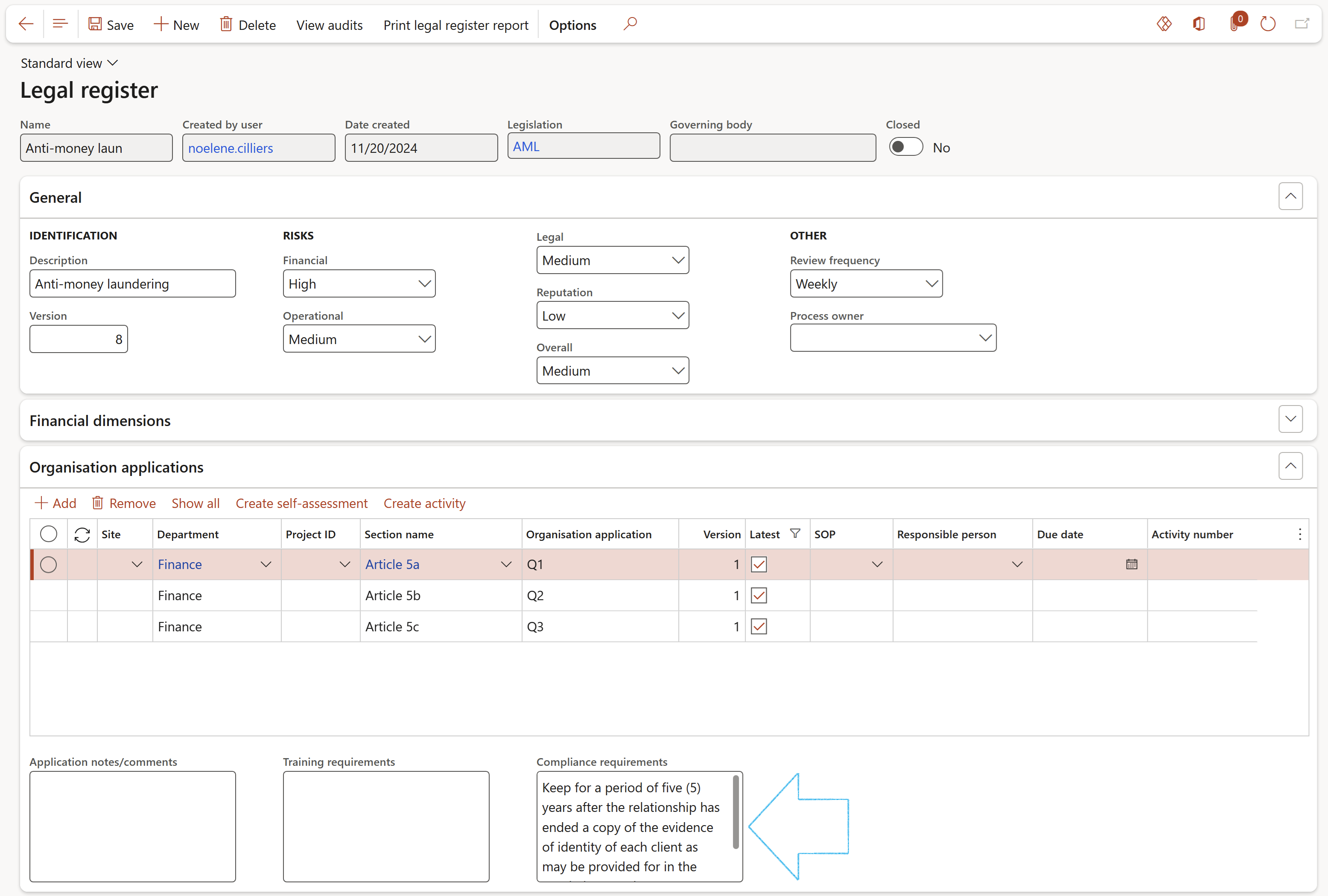
¶ Step 7.2: Create an audit
It is assumed that an Area of compliance has been created in order for an audit to be created
Go to: GRC > Compliance > All compliance audits
- In the Action pane, click on the New button
- On the Create new audit dialog:
- Under the AUDIT FILE field group, enter a Name and Description
- Under the AUDIT field group, enter an Audit name
- Click on OK
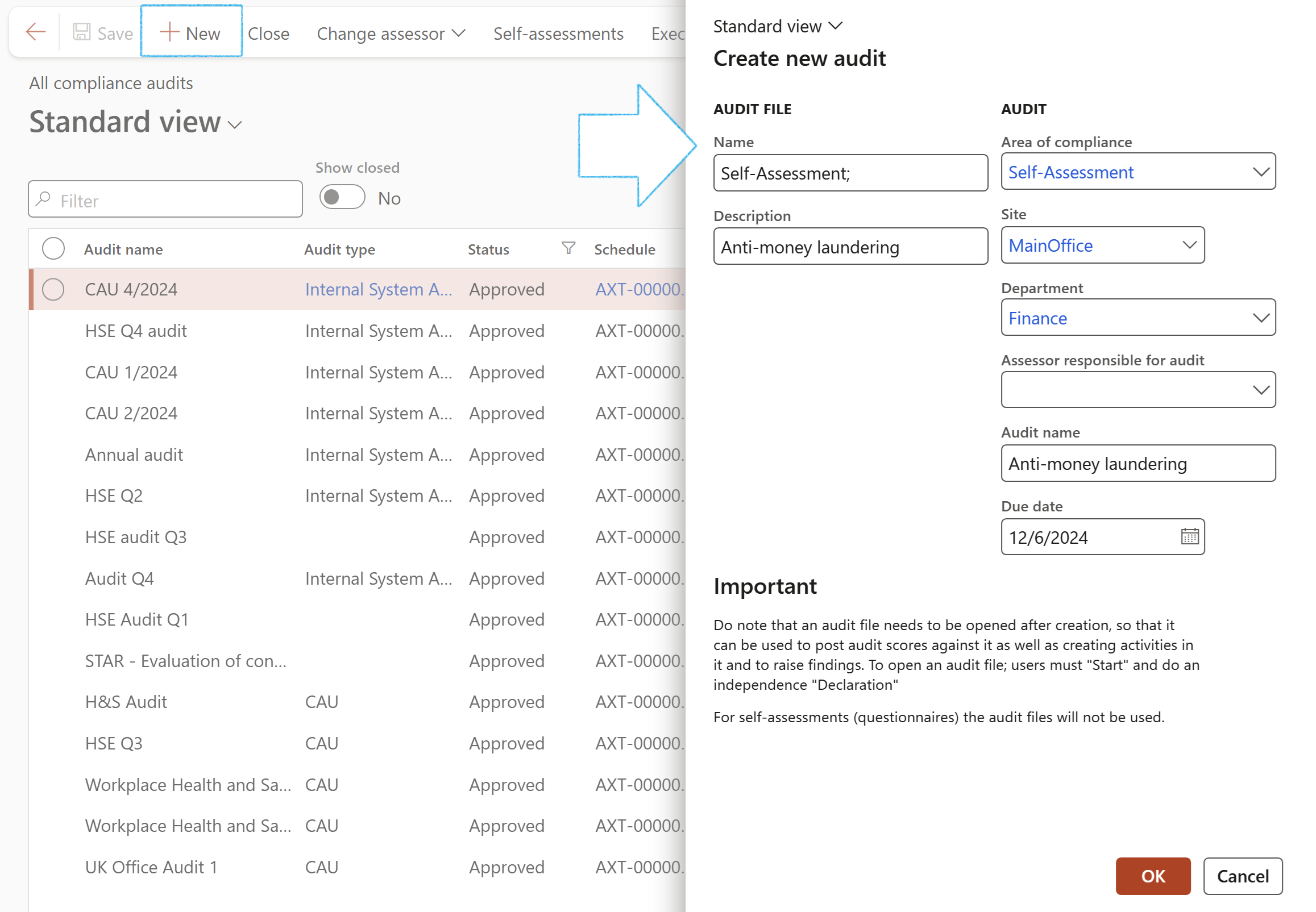
¶ Step 7.3: Create Self-assessment
Go to: GRC > Governance > Legal > Legal register
- Expand the Organization applications Fast tab
- Click on the Create self-assessment button
- On the Create self-assessment dialog:
- Select the relevant Question type from the dropdown list
- Select the relevant Questionnaire type from the dropdown list
- Select the relevant User right group from the dropdown list
- Move the Enable back button slider to Yes to allow users to go back to the previous question on the questionnaire
- Move the Allow overview slider to Yes to allow users to view all the questions in the questionnaire on one page, as opposed to only one at a time
- Move the Show comments slider to Yes to allow users to enter comments on the questionnaire
- Click on OK
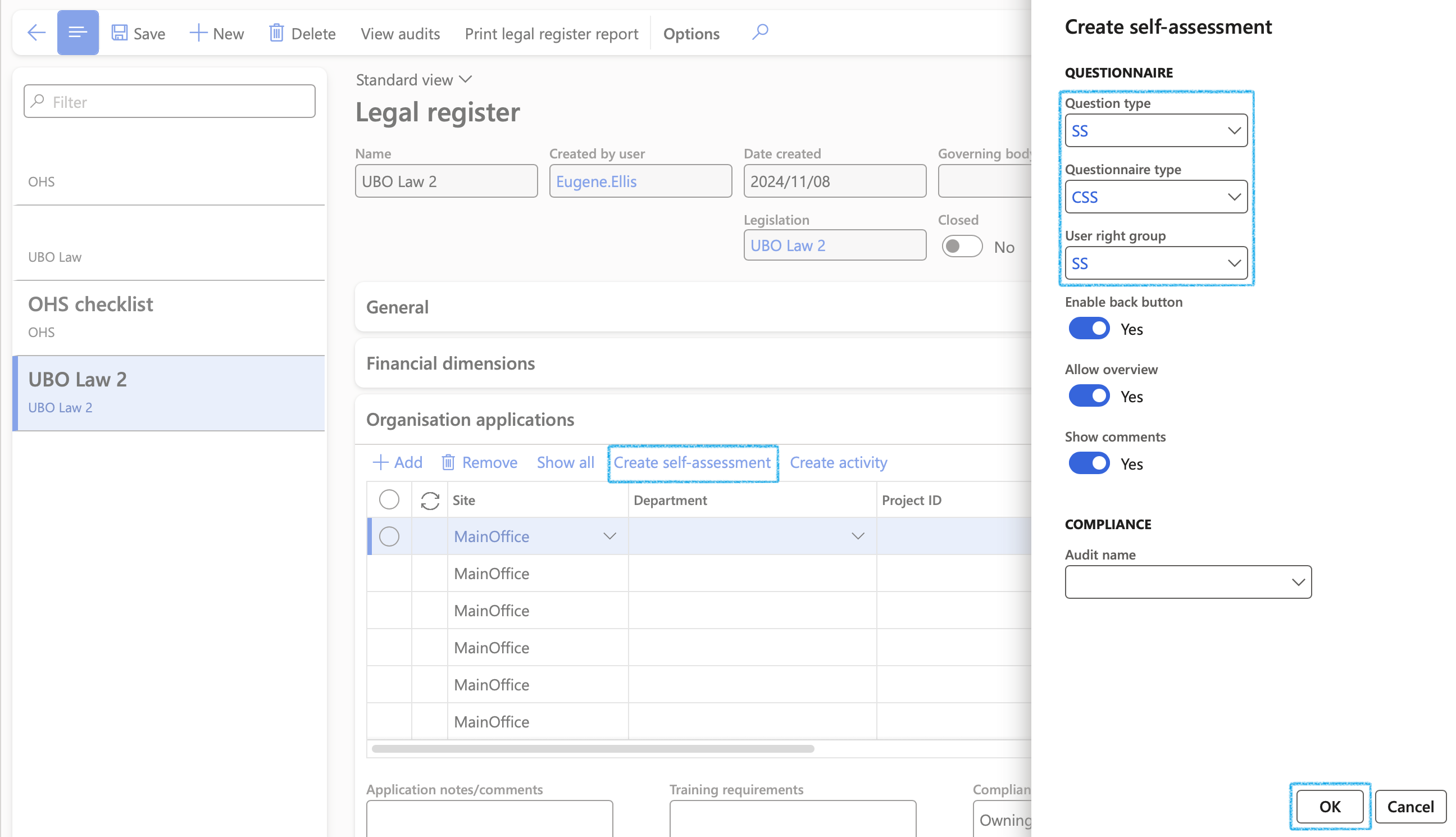
To see who the questionnaires have been created for, go to: GRC > Compliance > Setup for compliance > Self-assessments created
- Expand the Introduction Fast tab and type an introduction/instruction for the questionnaire
- In the Action pane, click on the User rights button to see the list of users that the questionnaire has been assigned to
- In the Action pane, click on the Questions button to see the list of questions in the questionnaire
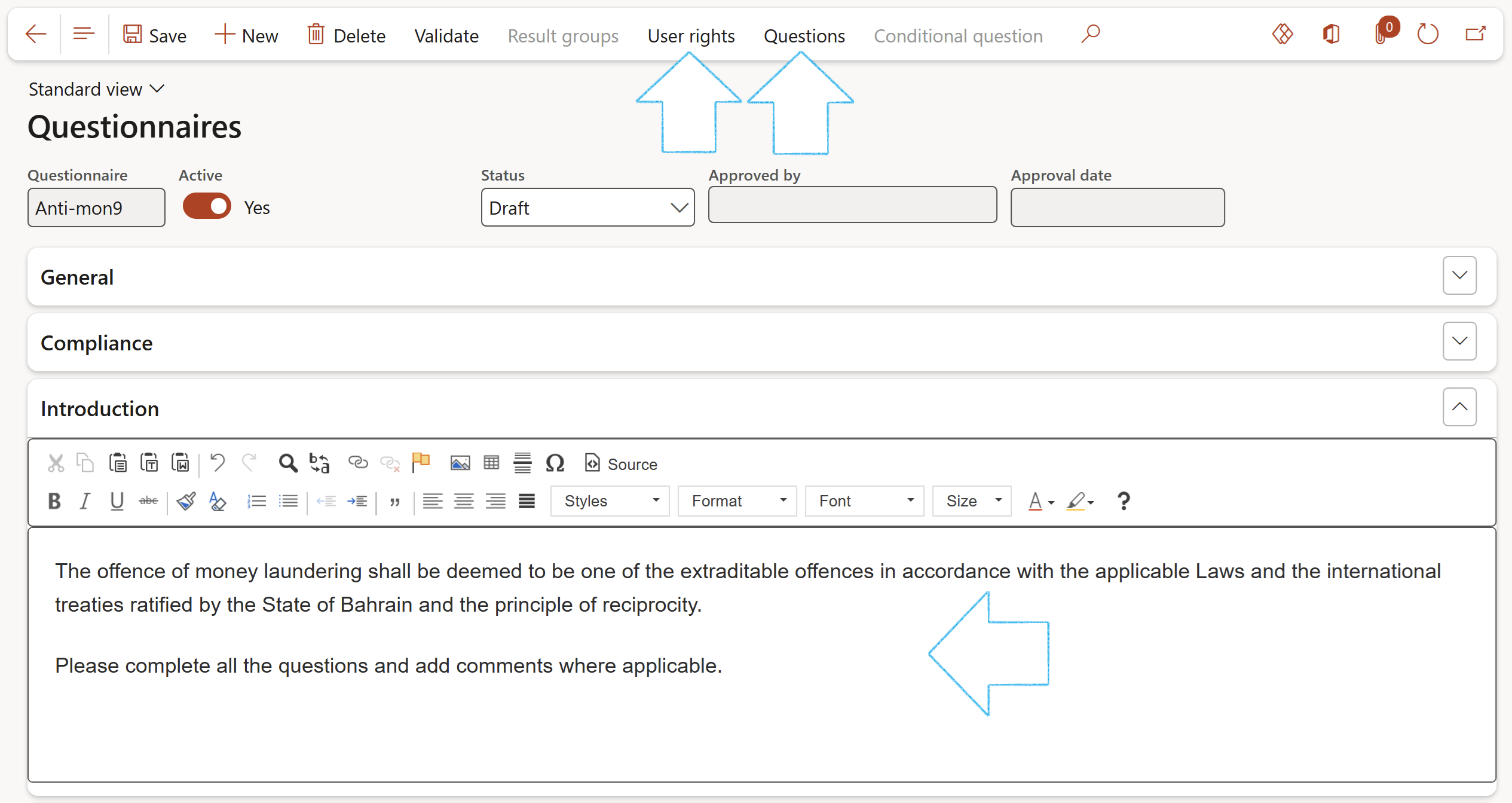
¶ Step 7.4: Complete questionnaire
There are two places where users can complete questionnaires from:
Go to: GRC > Compliance > Self-assessments to be done
OR
Go to: Human resources > Workspaces > Employee self service
- Click on the Questionnaires assigned to me tile
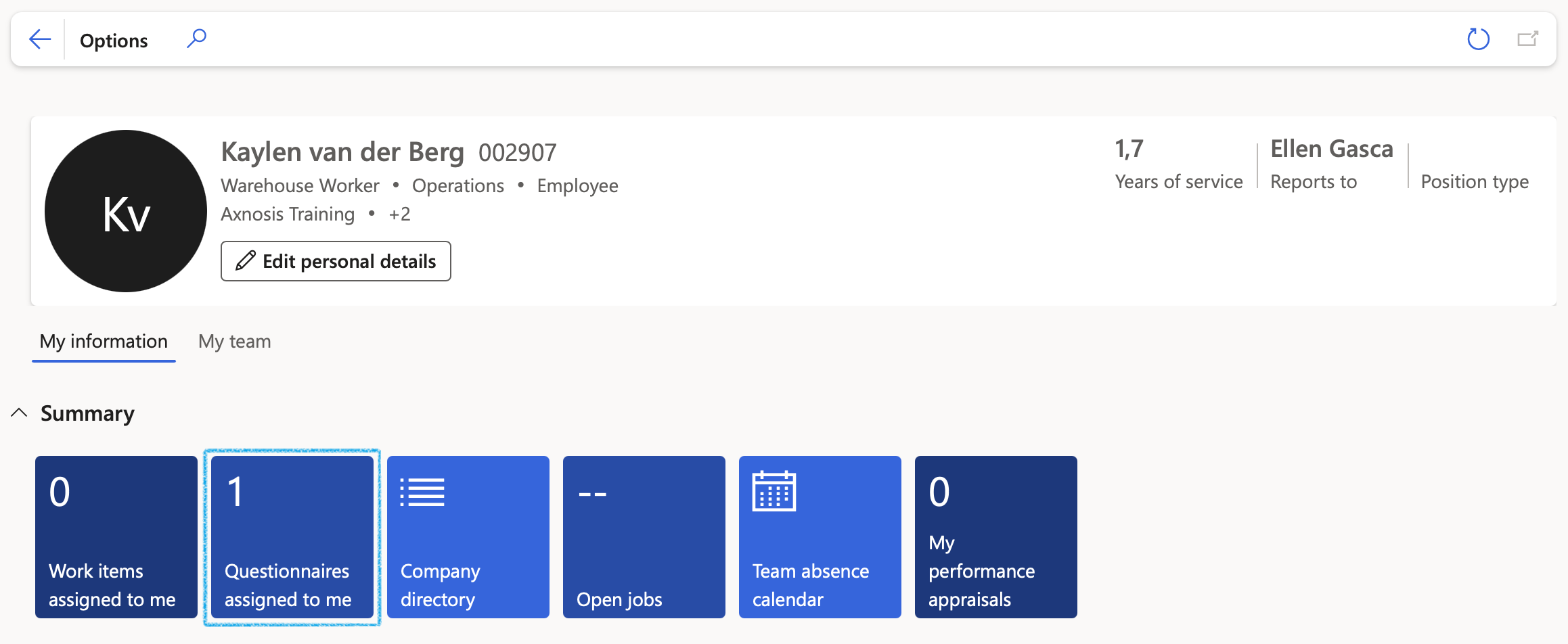
- Select the relevant questionnaire and click on the Start button
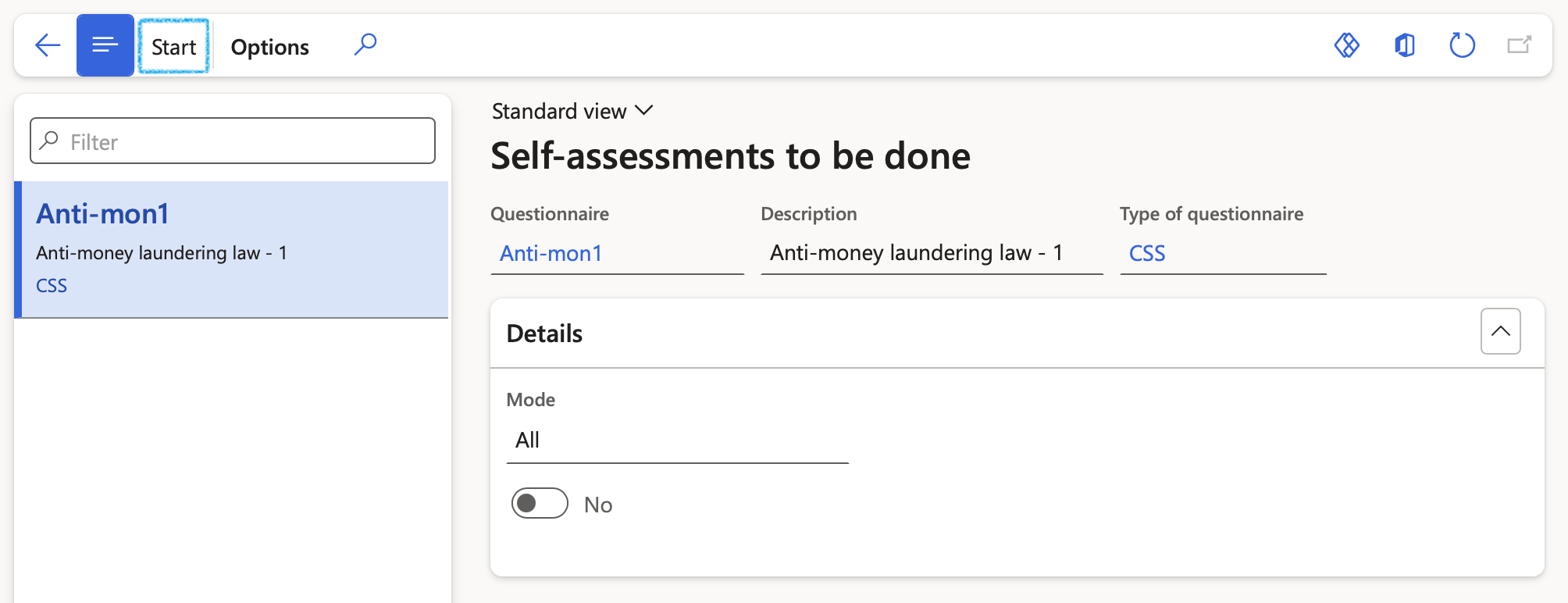
- Answer the question and click on the Forward button to go to the next question
- Click on the End button once all the questions have been answered
Use the buttons at the bottom of the screen see an overview of all the questions, add comments or go back to the previous question
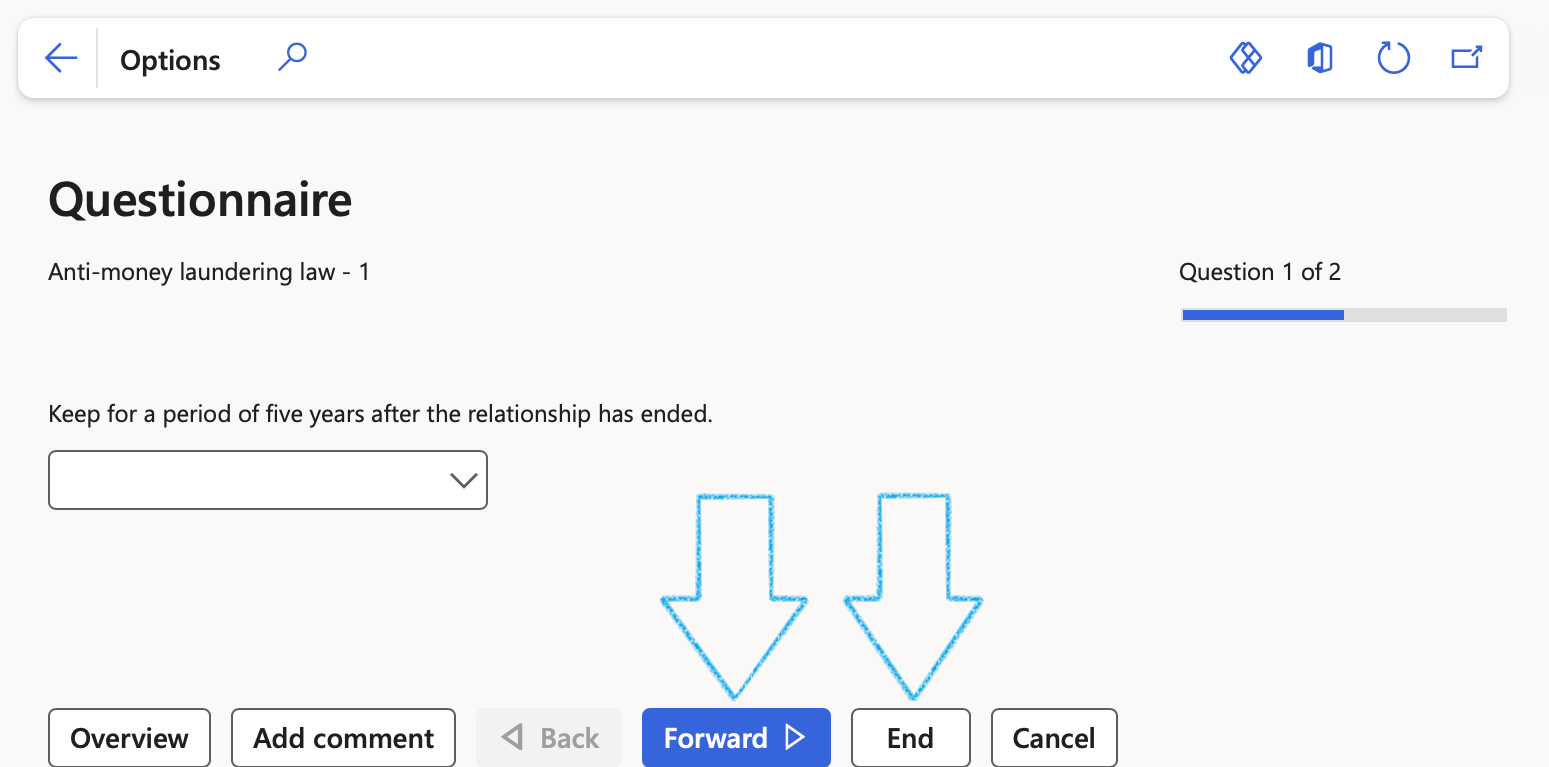
¶ Step 7.5: Create a case from the Legal register
Go to: GRC > Goveranace > Legal > Legal register
- Open the relevant Legal register
- In the Action pane, click on the Create case button
- On the New case dialog, select Legal in the Case category field and complete the dialog with the relevant information
- Click on the Create button
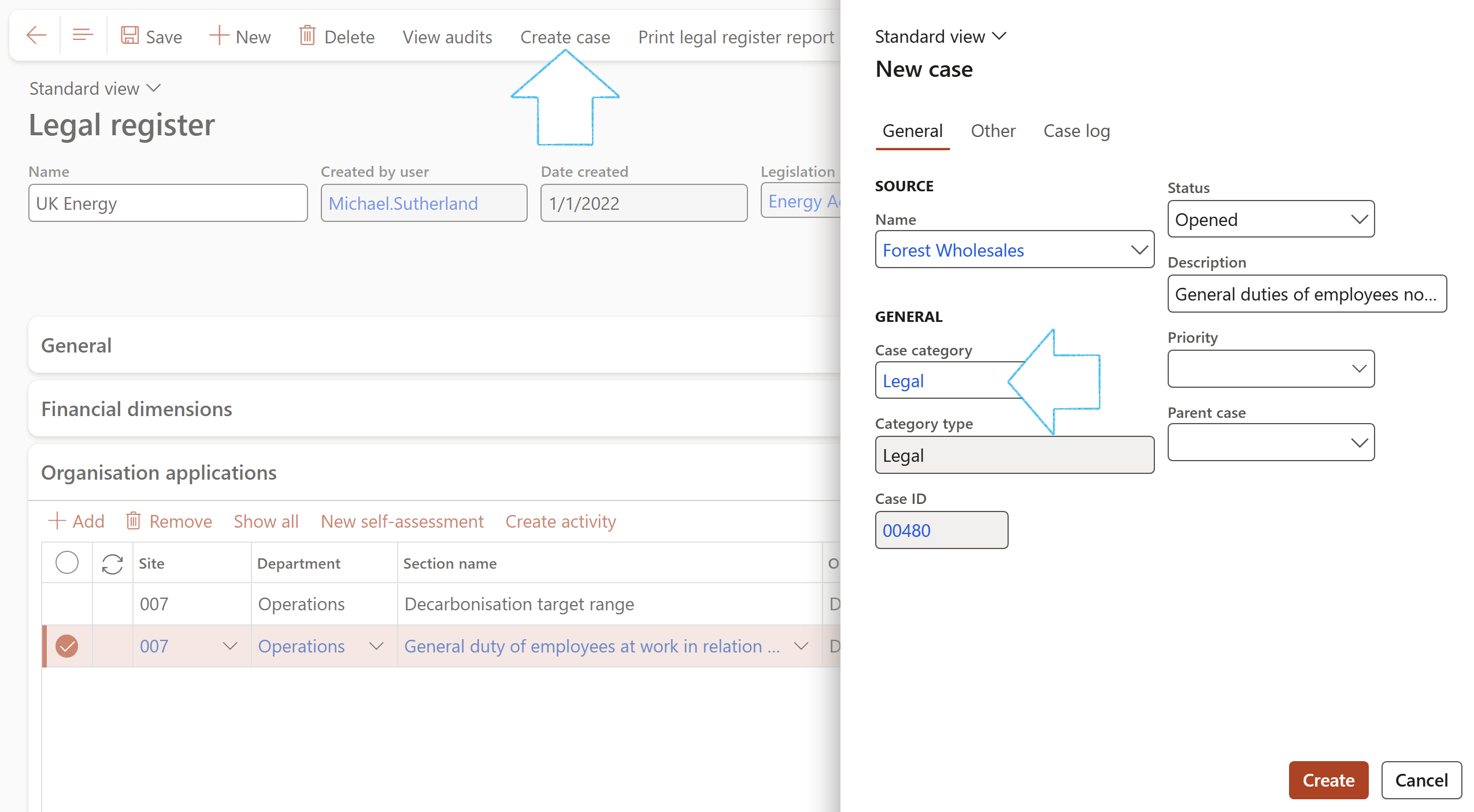
A record with the new Case details will be added under the Associations Fast tab

¶ Step 8: Legal panel
A panel can consist of just one firm but typically comprises more. It is recommended that a company has two or more firms on its panel as it may need specialist legal counsel in different areas across the business, and because the company will benefit.
Go to: GRC > Governance > Legal > Legal panel
- On the Action pane, click on the New button
- Select the relevant Legal category from the dropdown list
- Enter a unique Number for the Legal panel
- Enter a brief Description of the Legal panel
- Select the relevant Panel member from the dropdown list
- Select the worker Responsible for the Legal panel, from the dropdown list
- Select the Legal panel Status from the dropdown list
- Select the Legal panel Status date
- Select the Expiration date for the Legal panel

The following has to be setup on the Vendor in order to display on the Legal panel:
- Addresses Fast tab: Address details
- Contact information Fast tab: Contact numbers/addresses
- Purchasing demographics Fast tab: Primary contact
¶ Step 9: Deed register
It is assumed that Fixed assets have been setup in order to use the Deed register
Go to: GRC > Governance > Legal > Deed register
- On the Action pane, click on the New button
- Enter a unique Number for the register
- Enter a name for the Deed of transfer
- Select the relevant Fixed asset from the dropdown list
- Enter the name of the person/company that the deed is being Transferred to
- Select the Execution date of the transfer
- Indicate whether you have the Original title deed
- Enter any additional Comments

The following has to be setup on the Fixed asset in order to display on the Deed register:
- General Fast tab: Description
- Location Fast tab: Titleholder and Titleholder ID
¶ Step 10: Declaration of interest register
The Declaration of interests register enables all staff to be as open as possible and declare any actual or potential conflict of interest. It is the responsibility of all staff to ensure that they are not placed in a position which risks, or appears to risk, conflict between their private interests and their NRF duties.
Go to: GRC > Governance > Legal > Declaration of interest register
- On the Action pane, click on the New button
- On the New declaration of interest register dialog:
- The Declaration date/time will default to today’s date and current time, but can be edited
- Select the Worker who is declaring something, from the dropdown list
- Indicate whether the worker has Anything to declare by moving the slider
- Select the relevant Nature of interest of the declaration from the dropdown list
- Enter the Amount (If applicable)
- Select the relevant Currency from the dropdown list (If applicable)
- Enter any additional Comments in the note box provided
- If a meeting was held, select the relevant Meeting from the dropdown list
- Select the From date and To date for which the declaration is valid
- If the declaration is done on behalf of a vendor, select the relevant Vendor from the dropdown list
- Click on the OK button
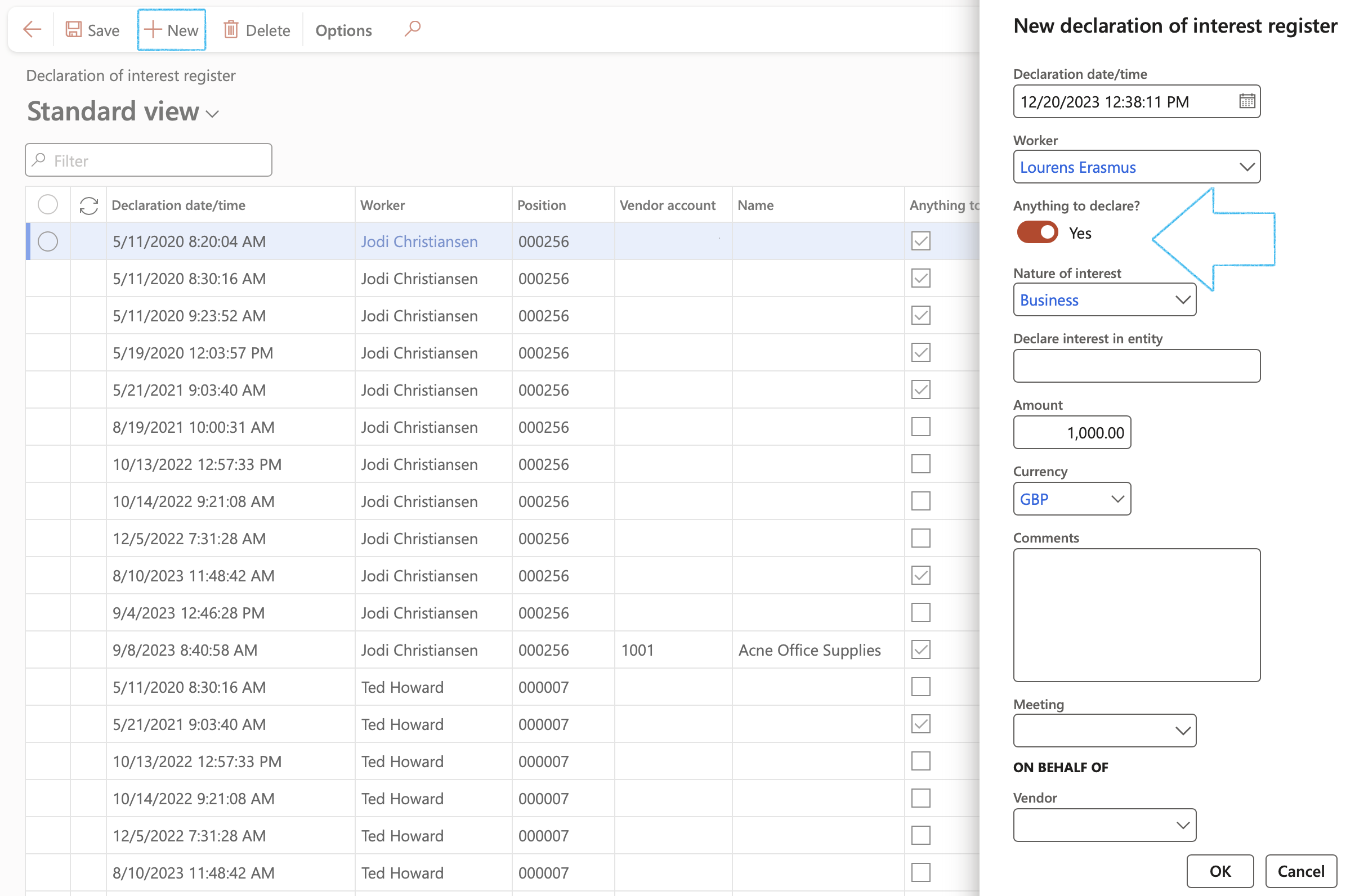

¶ Step 11: Gift register
The gift register is used to “file” details of the following:
- Gifts/donations received from vendors/customers
- Gifts/donations sent to vendors/customers/organizations
Go to: GRC > Governance > Legal > Gift register
The user can filter on Year, Site and/or Department to narrow down a search
If the Show donations slider slider is moved to Yes, donations will be included in the search

- On the left hand side of the Gift register, click on the relevant month
- On the Action pane, click on the New button
A new line will open on the right-hand side of the form
- Select the occurrence Date of gift/donation
- Enter a brief Description of the gift/donation
- Enter the Amount in transaction currency
- Select the relevant Currency from the dropdown list
- Enter the Amount in monetary standard (National currency)
- Select Direction of the transaction (was it donated or received)
- Enter the name of the Donor
- Select the Worker who received or donated the gift, from the dropdown list
- Enter the name of the Recipient (if the recipient was an external organization or person)
- Select the Status of the gift from the dropdown list
- Select the worker to whom the gift/donation was Reported, from the dropdown list
- Select the date on which the gift/donation was Reported
- Select the relevant Site from the dropdown list
- Select the relevant Department from the dropdown list
- Enter any additional Notes in the note box provided
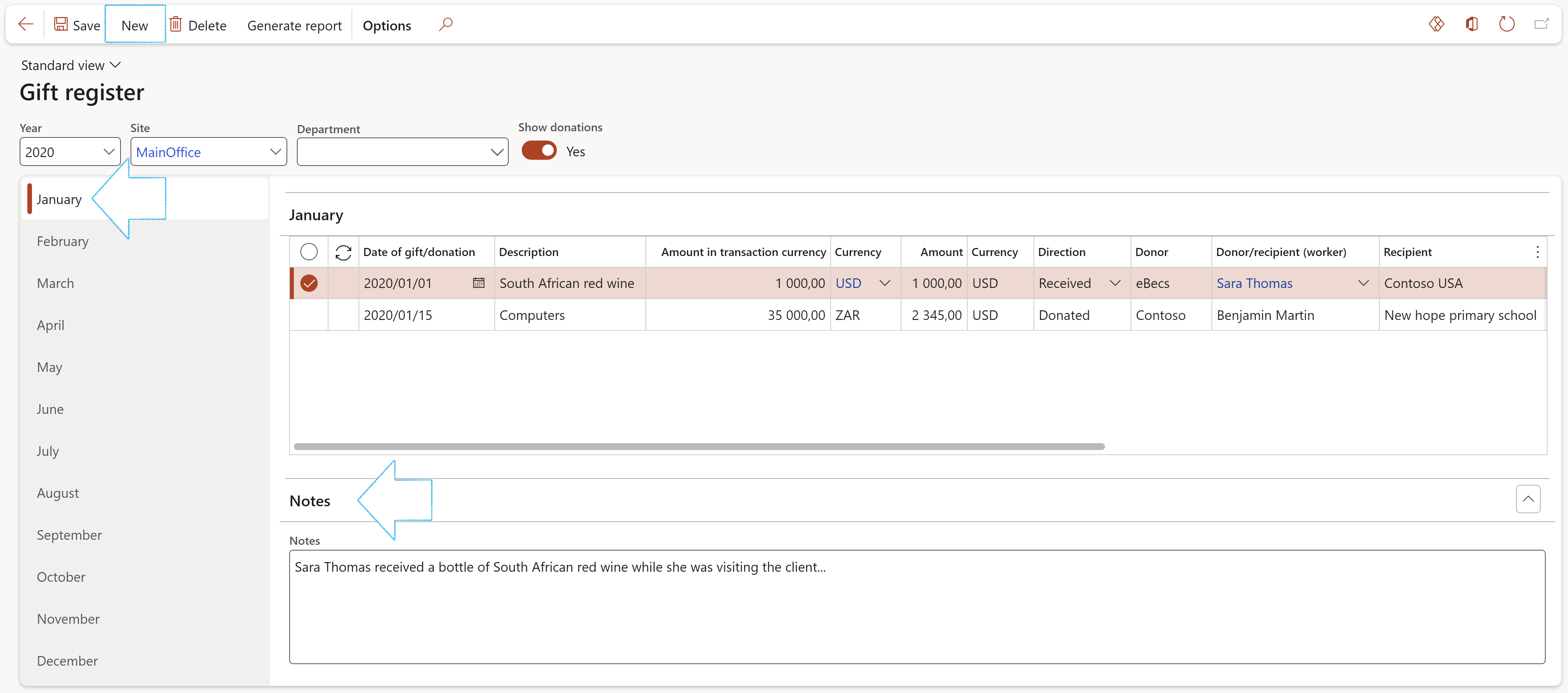
¶ Step 12: Trademark register
Go to: GRC > Governance > Legal > Trademark register
- On the Action pane, click on the New button
- Enter a unique number for the Trademark register
- Select the relevant Site from the dropdown list
- Select the relevant Department from the dropdown list
- In the Managed by field, select the relevant Vendor from the dropdown list
- Select the Responsible worker from the dropdown list
- Select the Original date for the Trademark register
- Select the Expiration date of the Trademark register
- Enter a brief Description of the trademark
- Select the relevant Trademark register Status from the dropdown list
- Enter any additional Notes
- Select the Next action date

¶ Step 13: Shareholder register
A Shareholder register is a list of active owners of a company's shares, updated on an ongoing basis. The register includes each person's name, address, and the number of shares owned. In addition, the register can detail the holder's percentage of shares owned.
Go to: GRC > Governance > Legal > Shareholder register
- On the Action pane, click on the New button
- Select the relevant Shareholder from the dropdown list
- Under the Shares section, click on the Add button
- Select the relevant Share class from the dropdown list
- Enter the Quantity of shares
- Enter the share %
- Select the On or before date
- Select the date of Disposal of shares
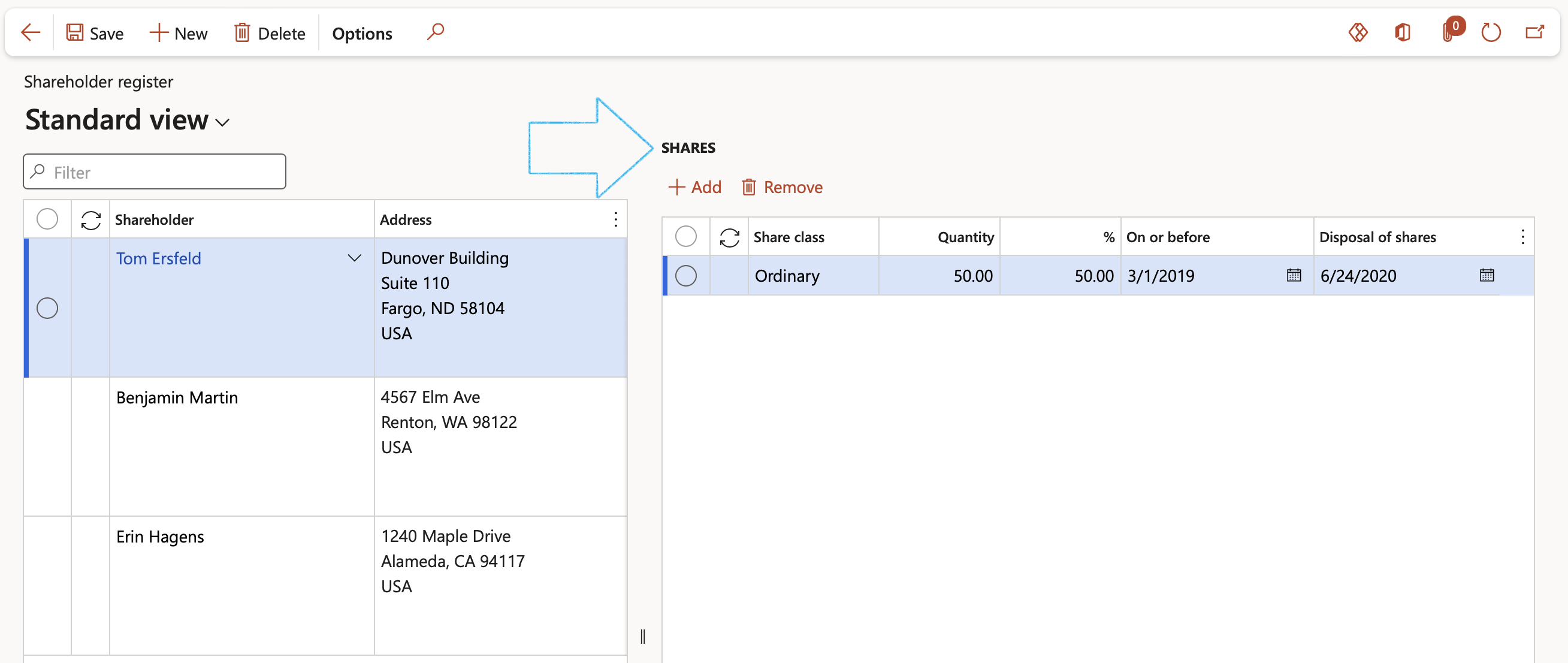
¶ Step 14: Board of directors
A board of directors (BofD) is the governing body of a company, whose members are elected by shareholders (in the case of public companies) to set strategy, oversee management, and protect the interests of shareholders and stakeholders.
Go to: GRC > Governance > Legal > Board of directors
- On the Action pane, click on the New button
- Select the relevant Worker from the dropdown list OR
- Select the relevant Vendor account from the dropdown list
- Enter the person's First name and Surname
- Enter the person's Identification number
- Enter the Date appointed and Cessation date of the appointment
- Select the Status of the appointment from the dropdown list
- Select the Nationality/country/region that the person is from, from the dropdown list
- In the Type field, select whether the person is an Executive or Non executive
- Select the Board position held by the person, from the dropdown list

When a meeting is created and BOD meeting is selected as the Meeting type, a question will pop up giving the user the option to automatically add the board of directors as attendees on the meeting. (Only confirmed members will be added)
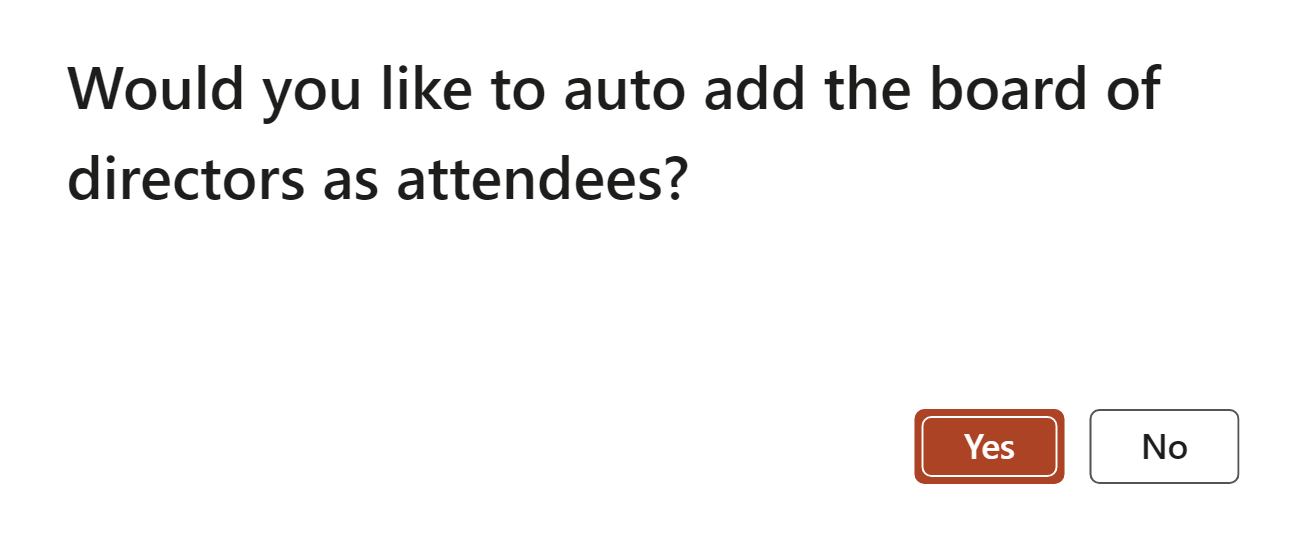
¶ Step 15: Rights register
A Rights register is a list of exclusive “Rights” granted to an individual/company for a period of time over a prescribed area of land, e.g. Mining rights, Prospecting rights etc.
Go to: GRC > Governance > Legal > Rights register
- On the Action pane, click on the New button
- On the New rights register dialog, enter the following:
- Enter a Name for the rights register
- Select the relevant Right type from the dropdown list
- Enter the Size of the area in hectares to the right
- Enter the number of Years requested for the right
- Select the relevant Vendor from the dropdown list
- Click OK

- On the new Rights register Header view, expand the Dates Fast tab
- Enter the Date on which the right was submitted
- Enter the Date on which the right was granted
- Enter the Renewal date of the right
- Click on the Lines view button
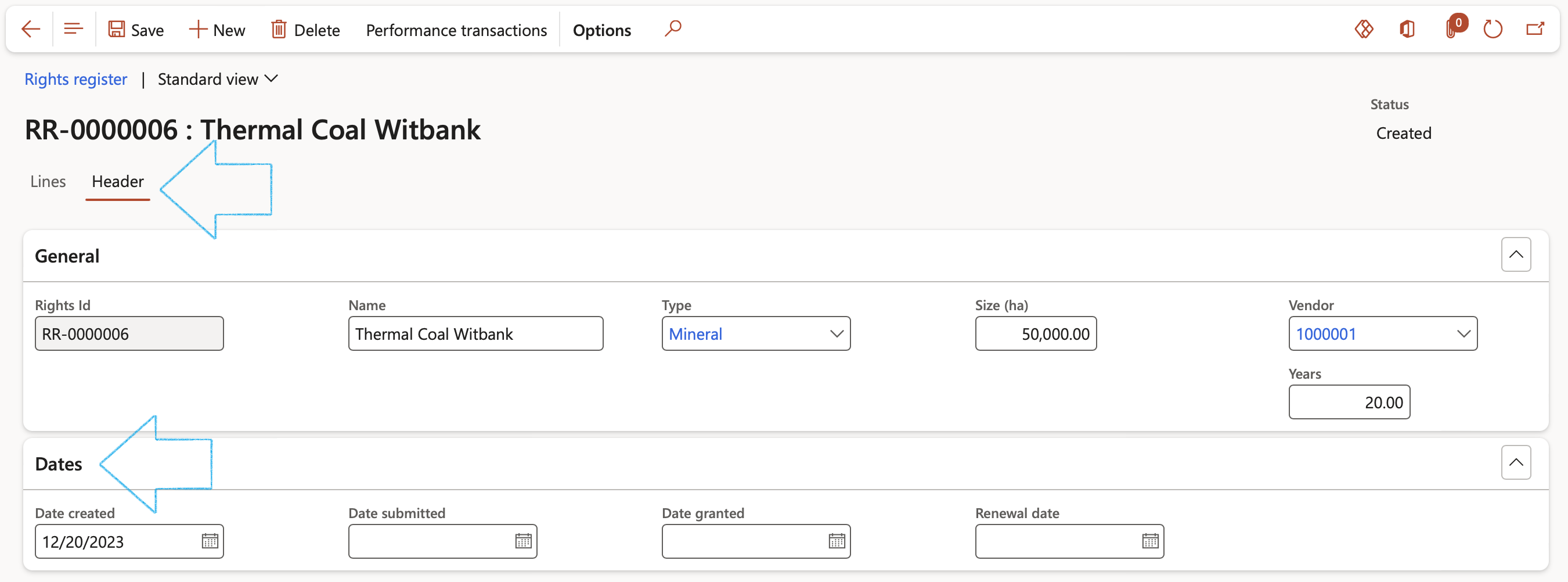
- Open the new Rights register Lines view
- Expand the Lines grid Fast tab
- Click on the Add line button
- Enter the Transaction date
- Select the relevant Project ID from the dropdown list
- Select the relevant Item number from the dropdown list
- Select the relevant Unit of measure from the dropdown list
- Enter the reserve Proved amount
- Enter the reserve Probable amount
- Enter the resource Measured amount
- Enter the resource Indicated amount
- Enter the resource Inferred amount
- Enter the resource Attributable amount
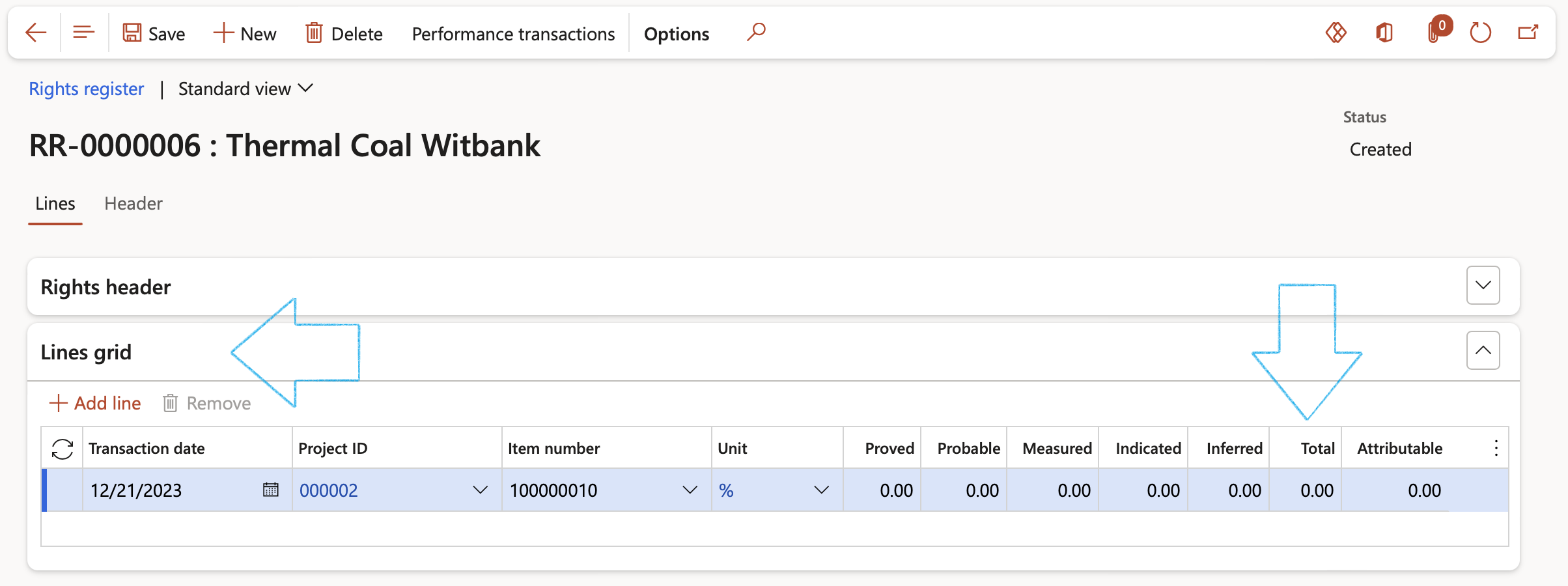
The Total will be calculated by the system
¶ Reporting
¶ Step 16: Print the Legal register report
Go to: GRC > Governance > Reports and inquiries > Legal register report
OR
Go to: GRC > Governance > Legal > Legal register
- On the Action pane, click on the Print legal register report button
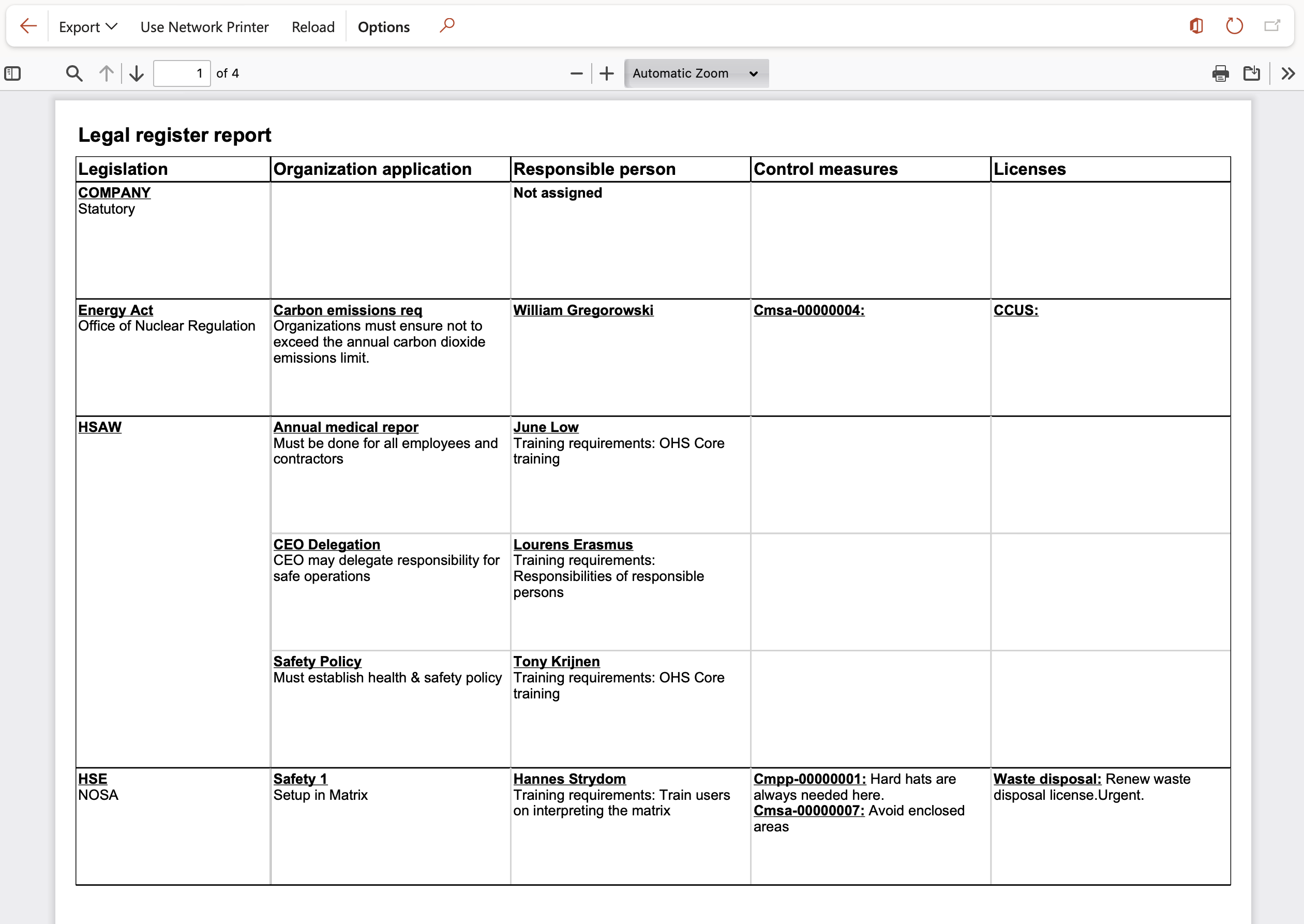
¶ Step 17: Print the Compliance audit self-assessment report
Go to: GRC > Compliance > All compliance audits
- Select the relevant audit (record)
- In the Action pane, click on the Print button and select Self-assessment from the list
The Self-assessments button will open a list of all the questionnaires/self-assessments linked to the selected audit

- On the Self-assessment dialog:
- Select the Self-assessment answer group that you want to print
- Click on the OK button
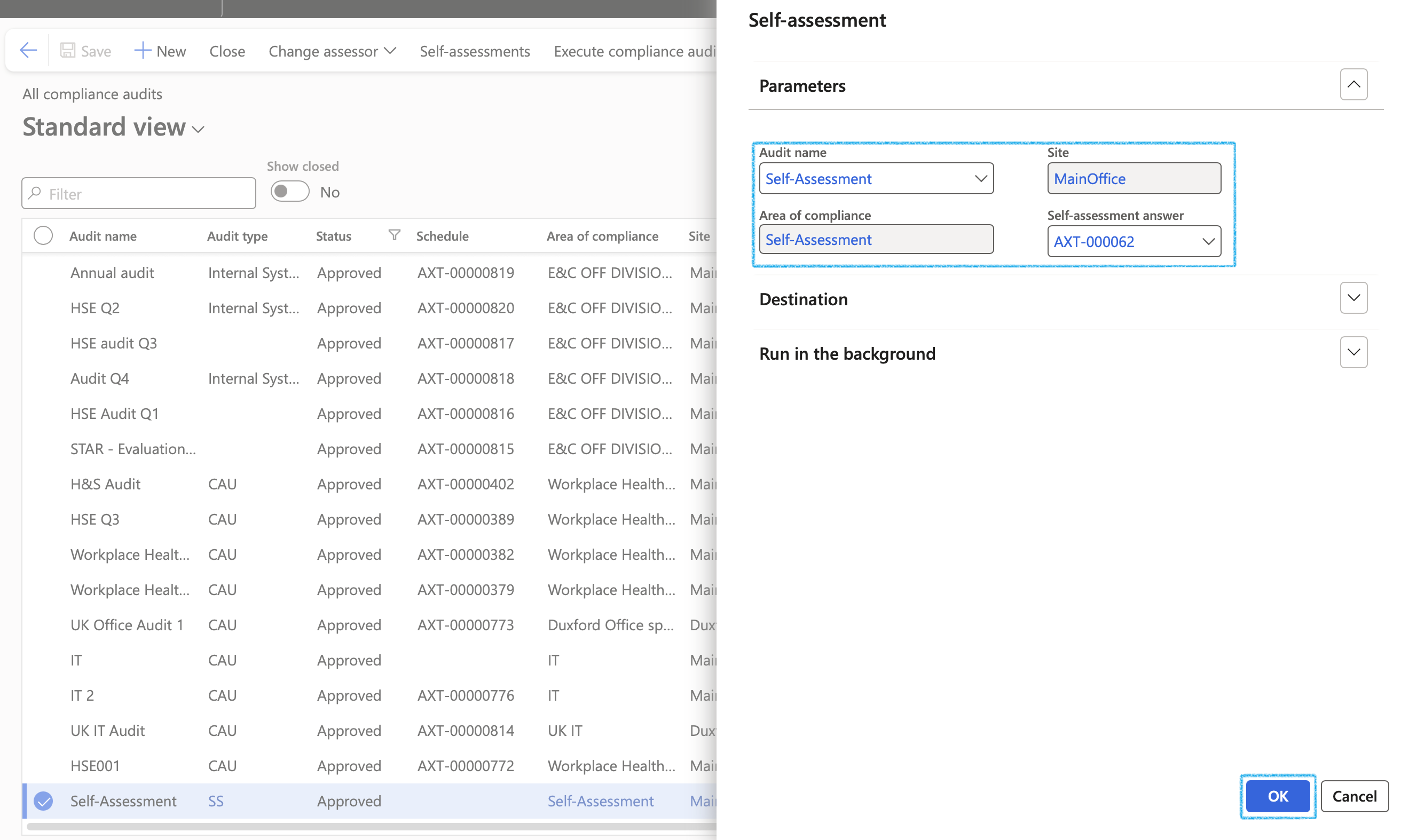

¶ Step 18: Print the Declaration of interest report
Go to: GRC > Governance > Legal > Declaration of interest register
- On the Action pane, click on the Print button
- Select the relevant parameters for the report
- Click OK
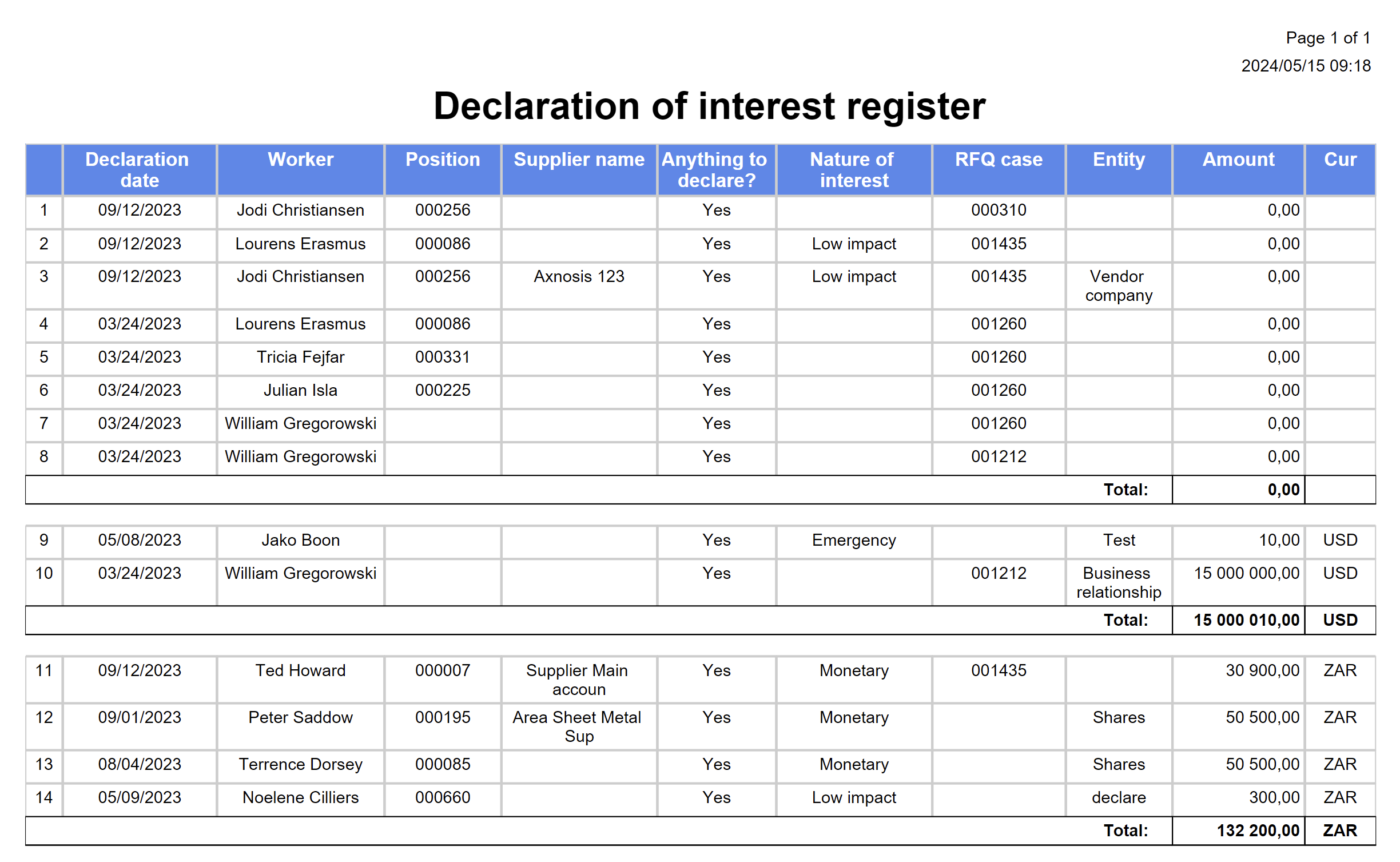
¶ Step 19: Print the Gift register report
Go to: GRC > Governance > Legal > Gift register
- On the Action pane, click on the Generate report button
- Select the relevant parameters for the report
- Click OK

¶ Step 20: View the Enterprise legal and contracts workspace
Go to: GRC > Workspaces > Legal, Contracts and Tender management
- Open the Enterprise legal and contracts Index tab

